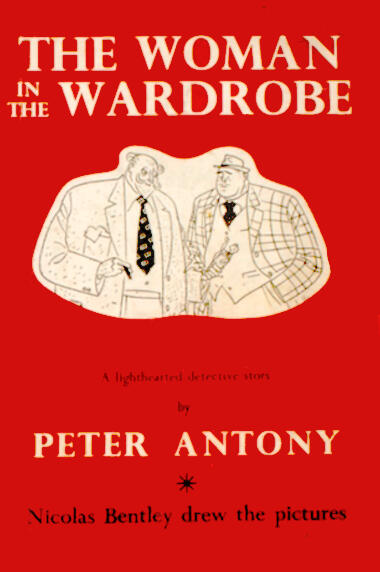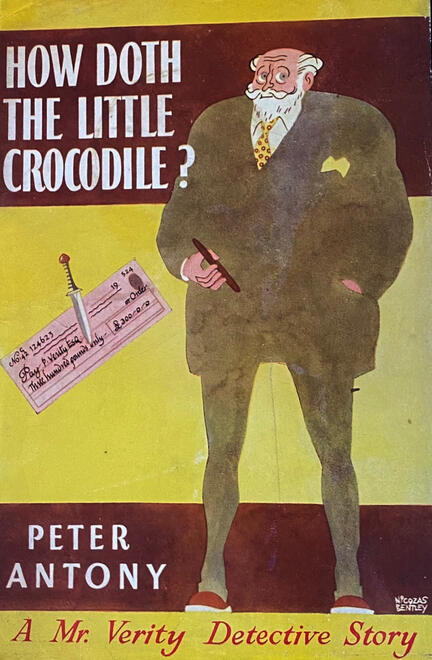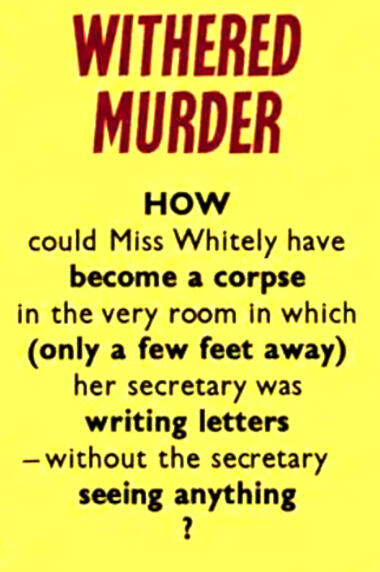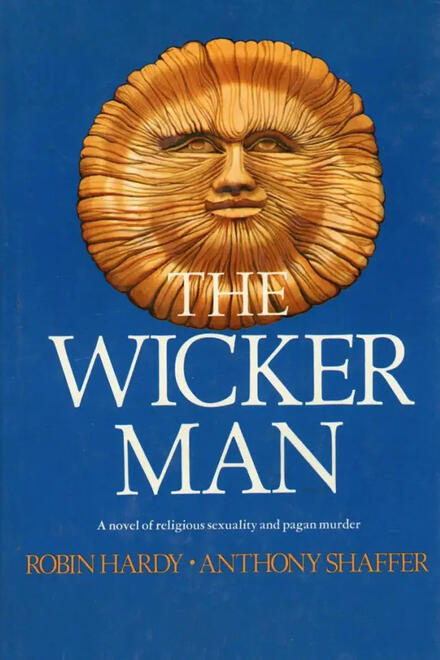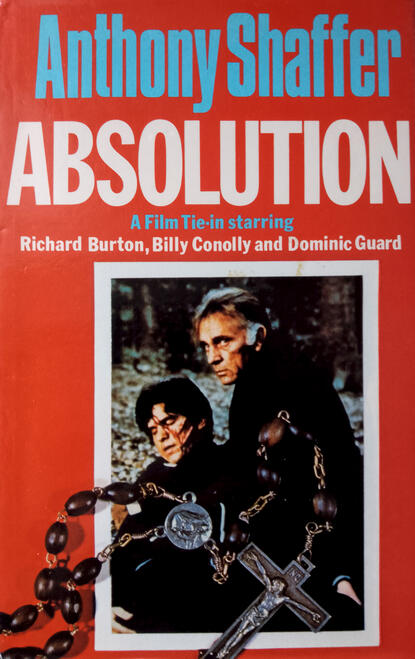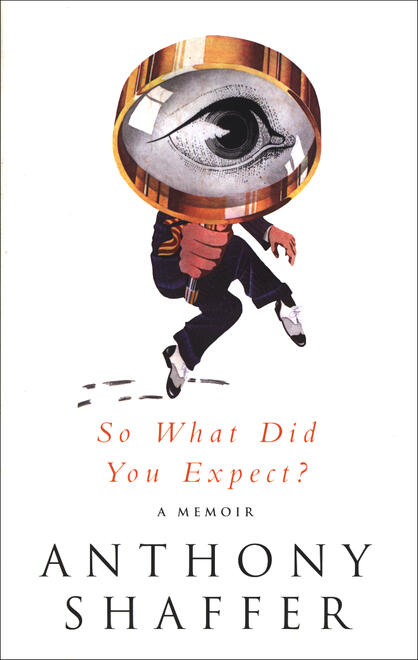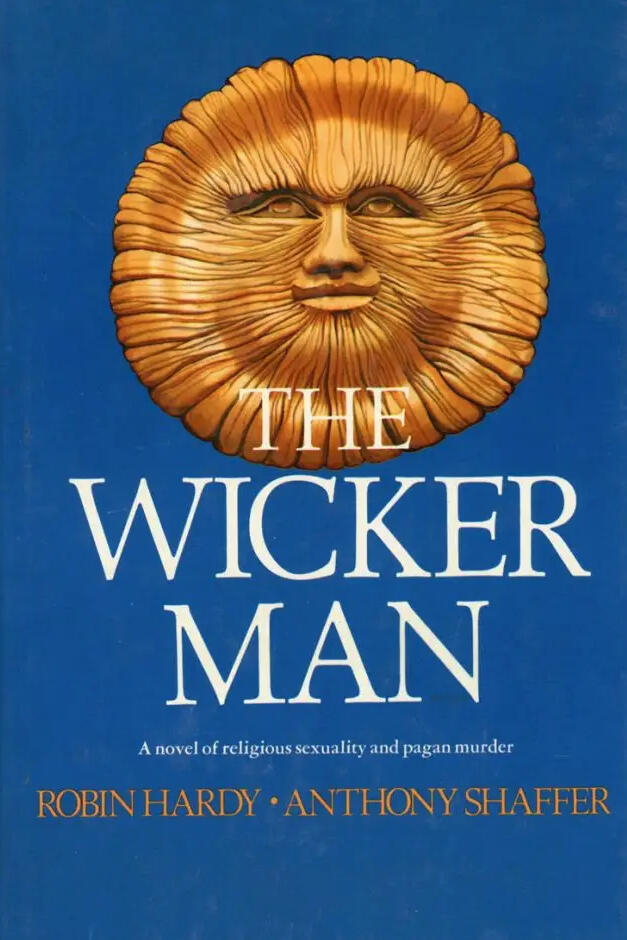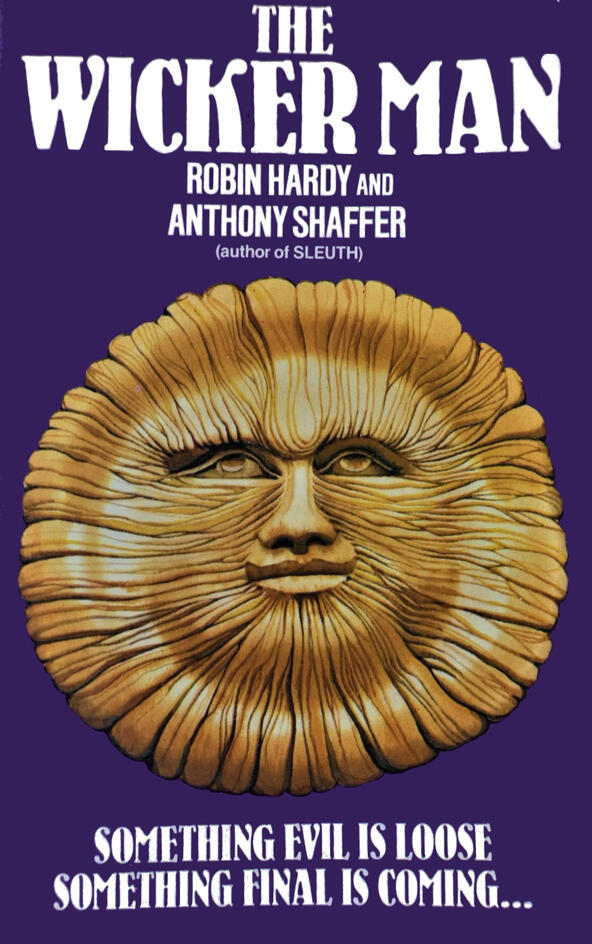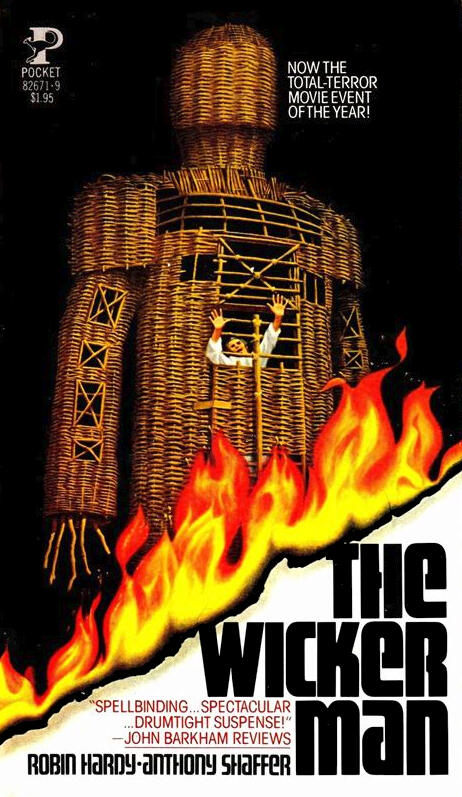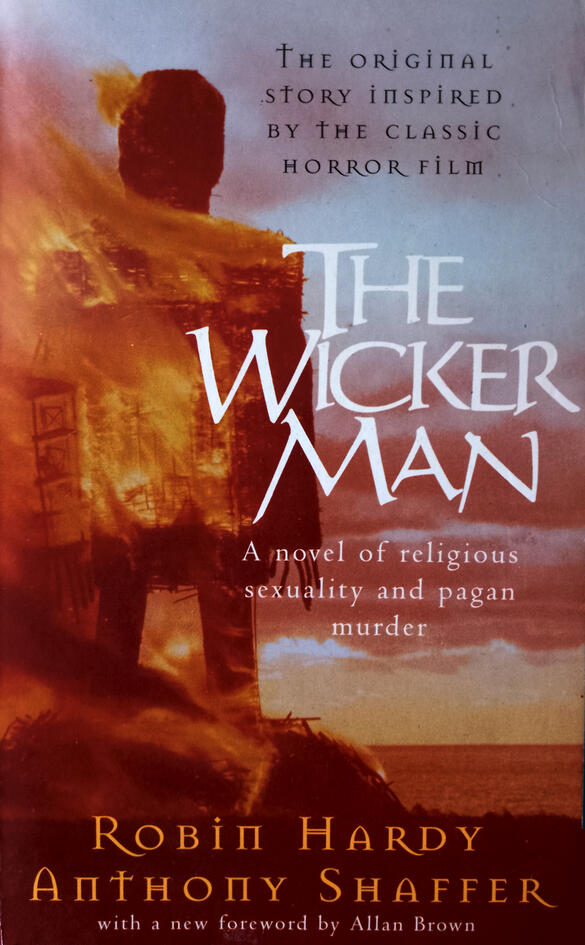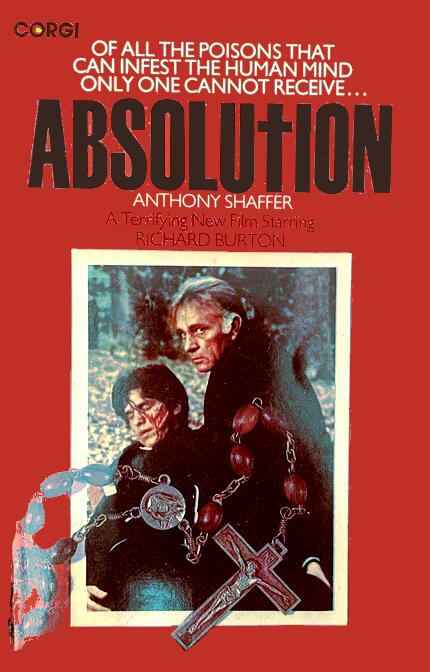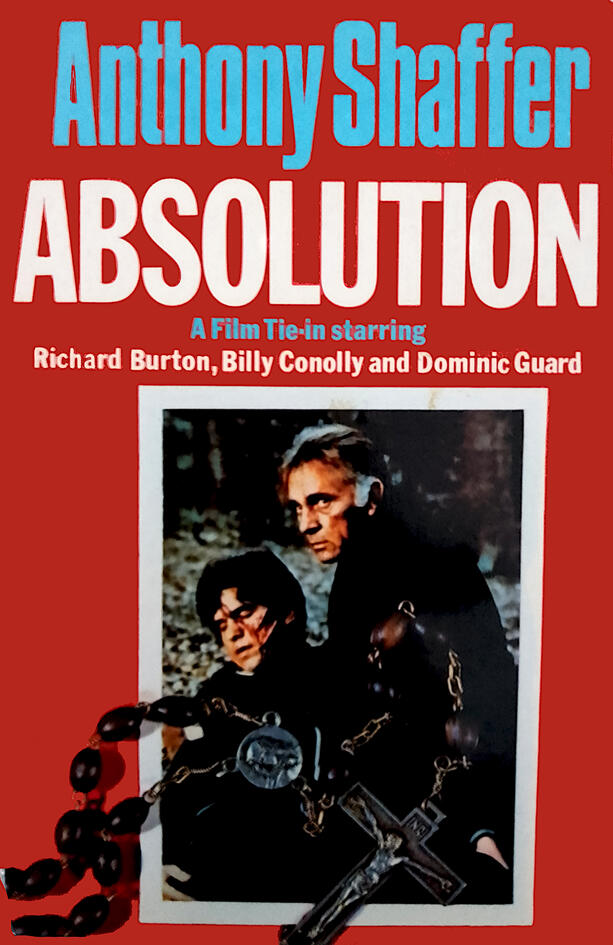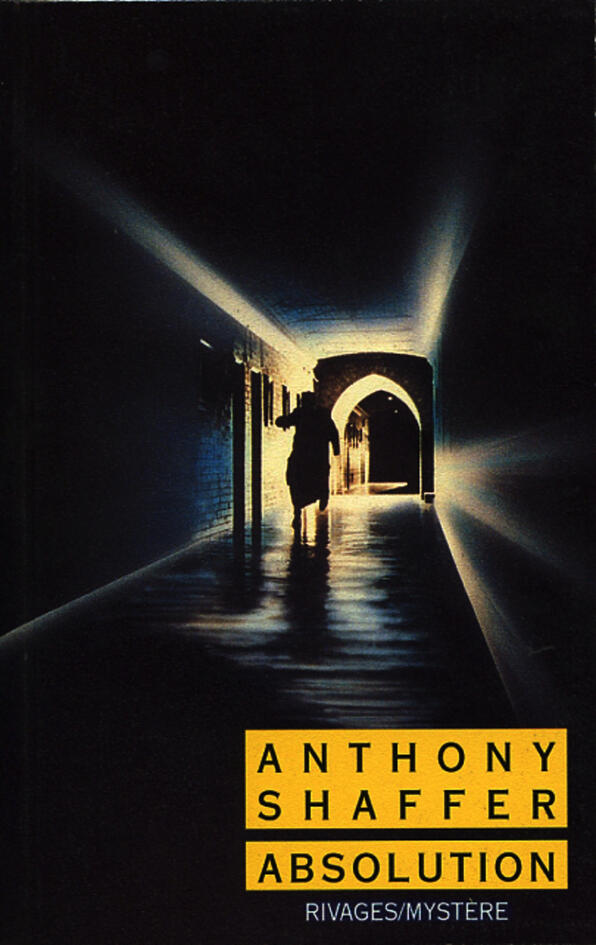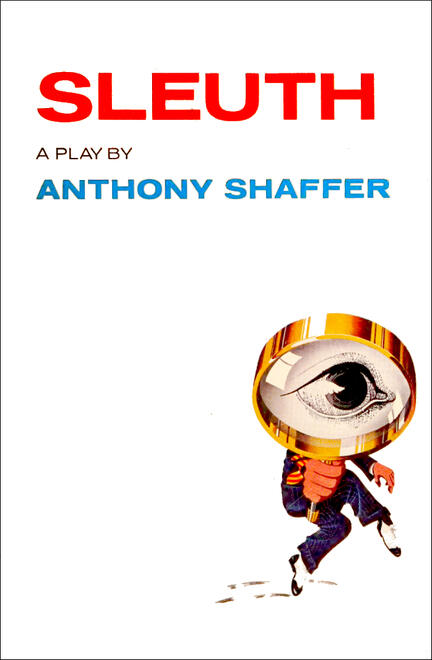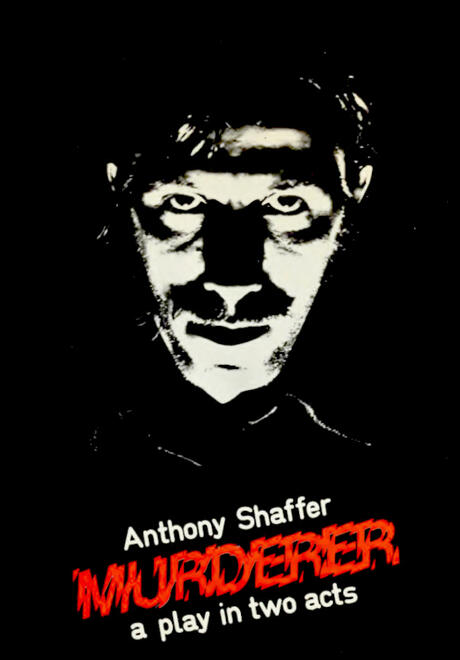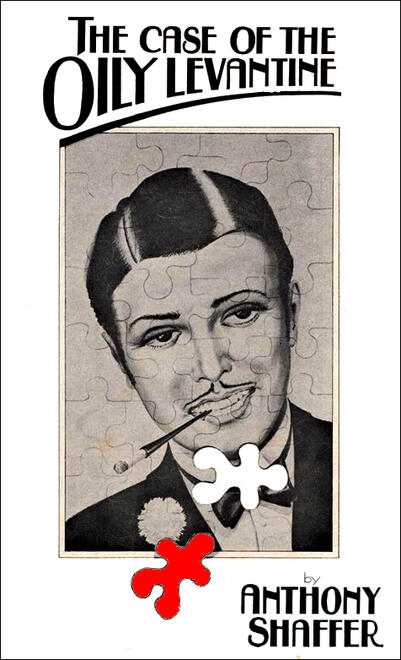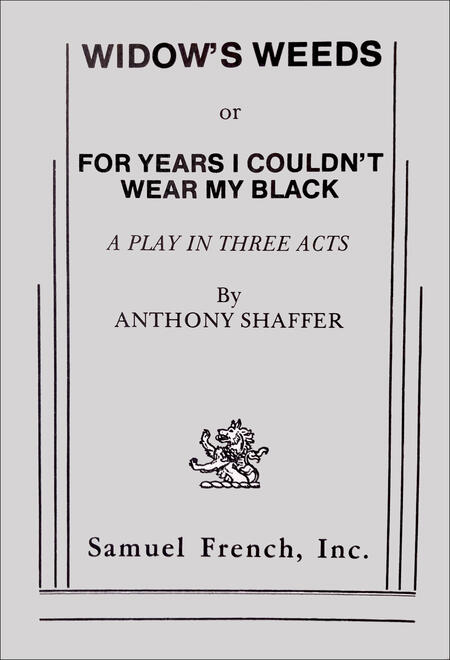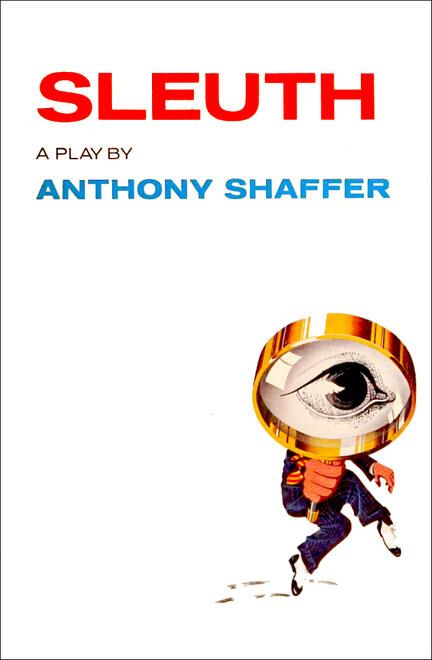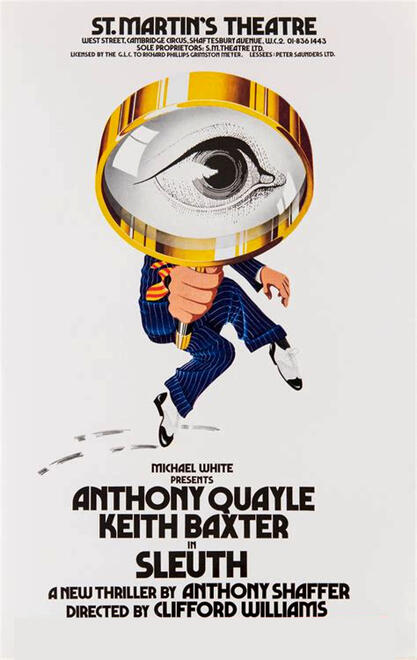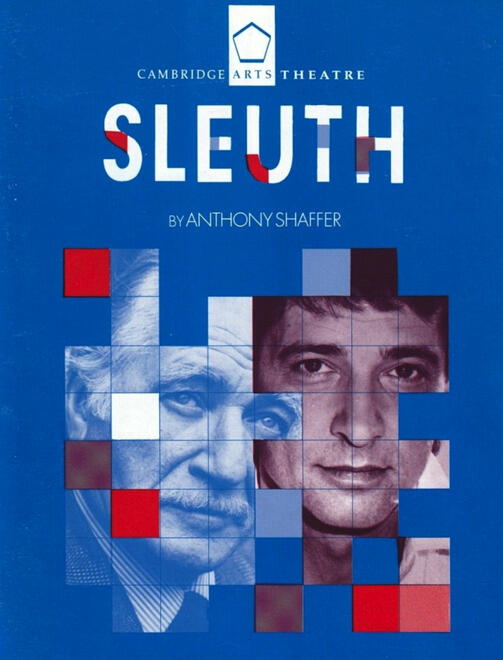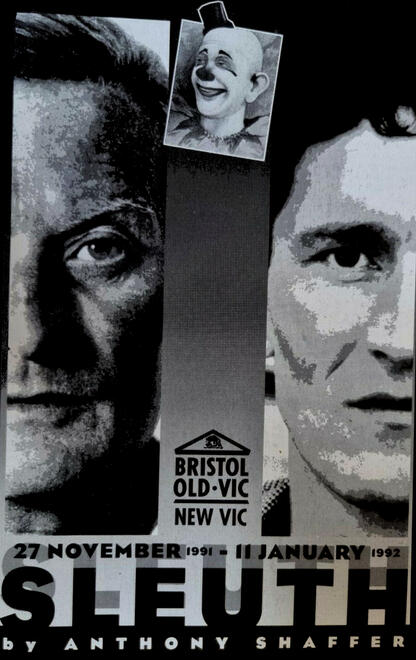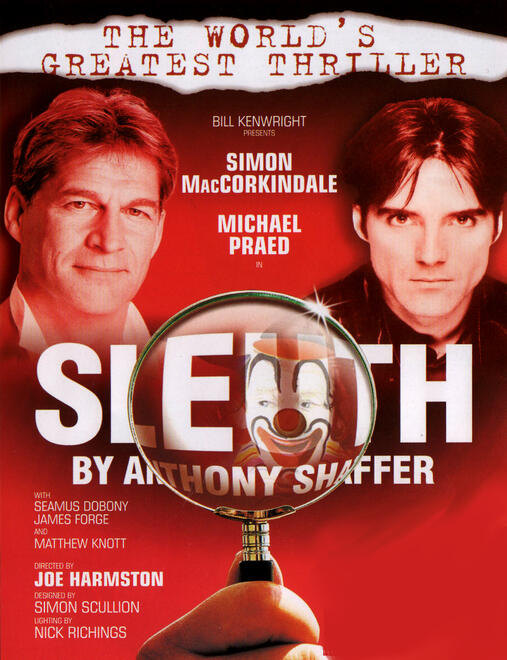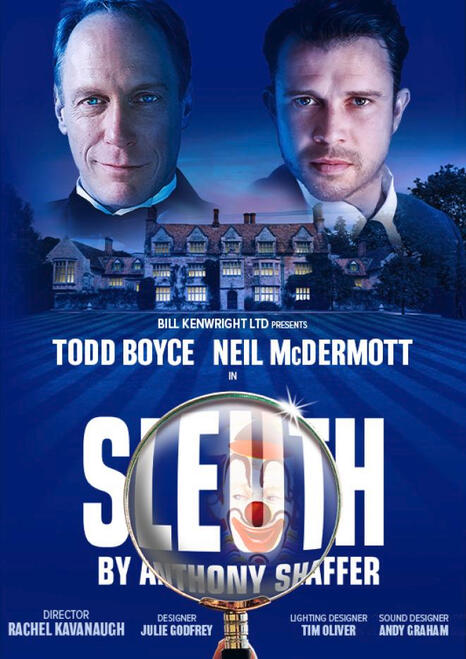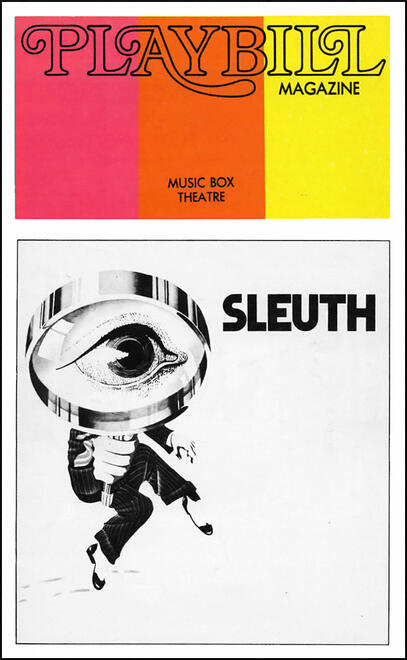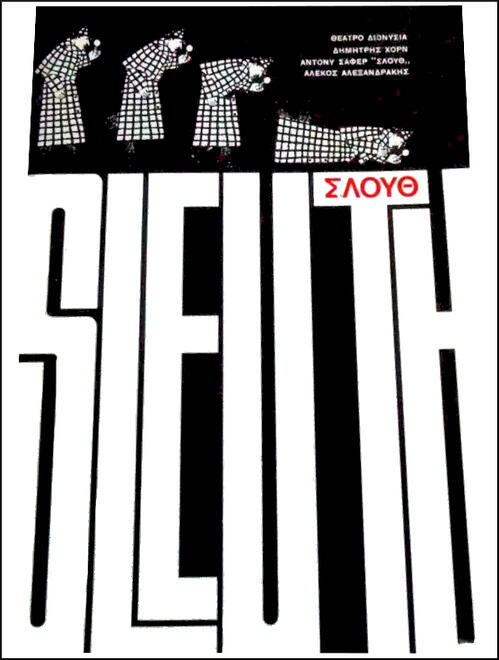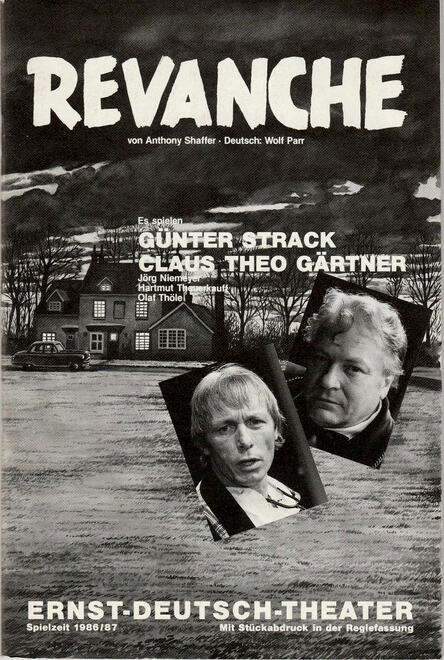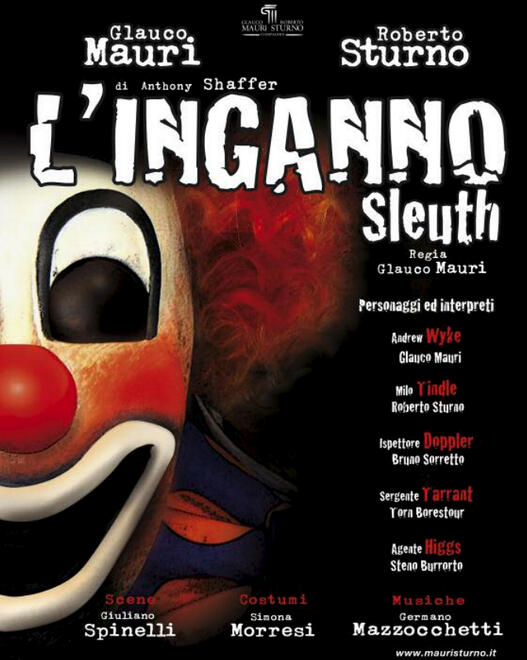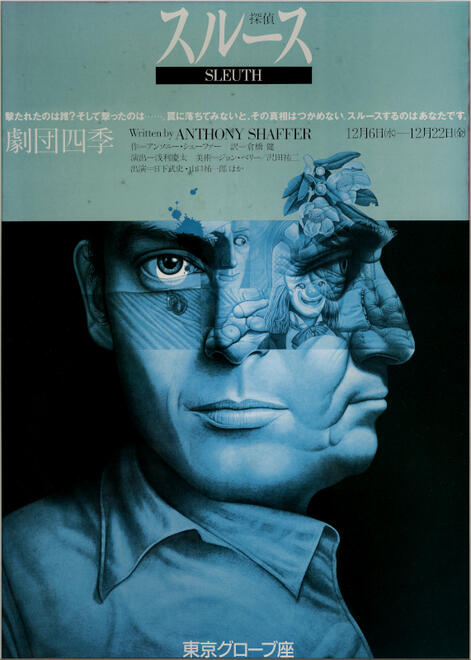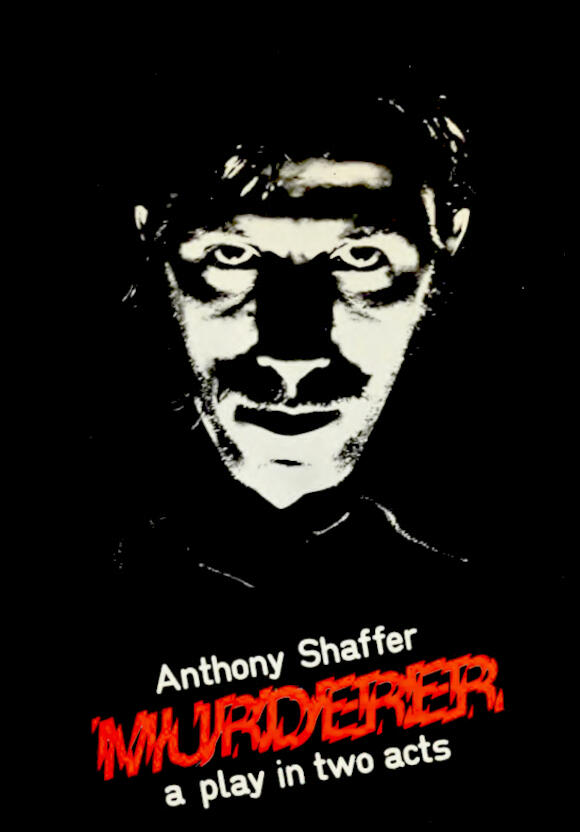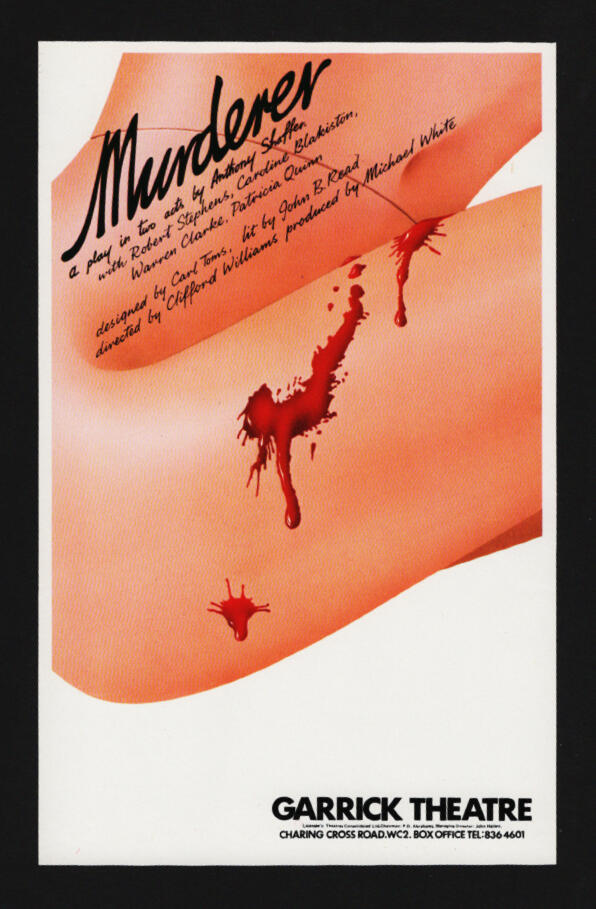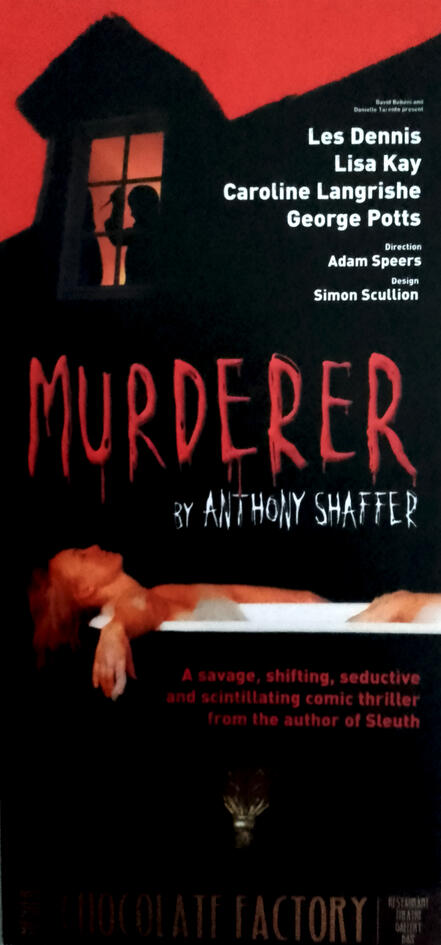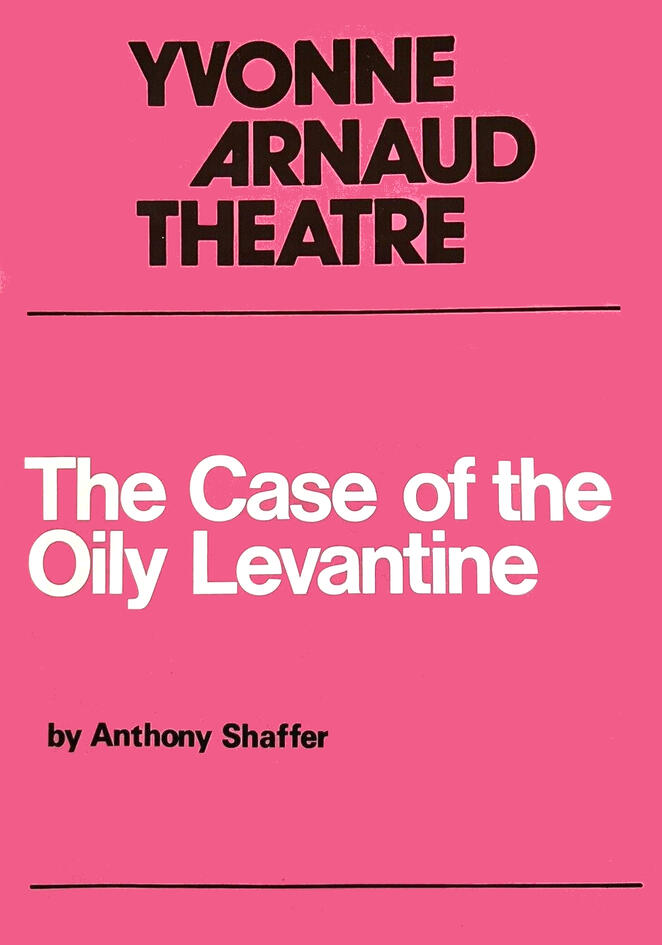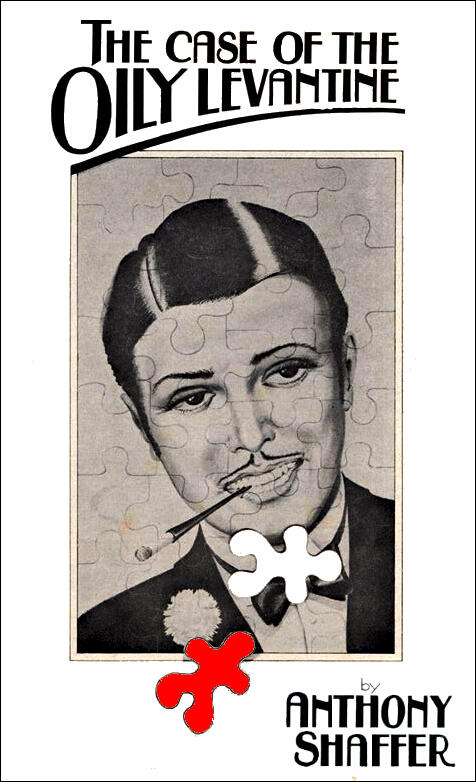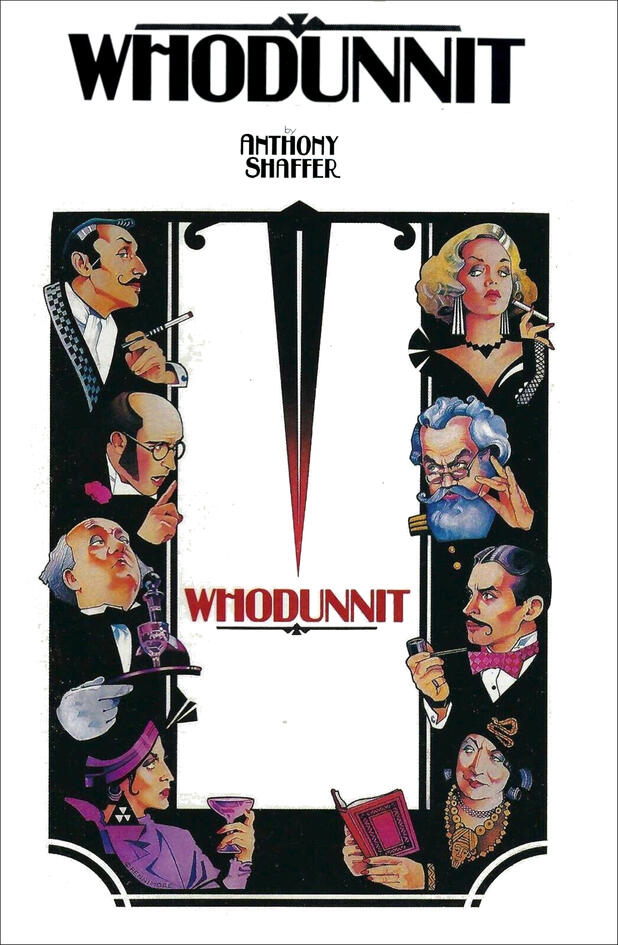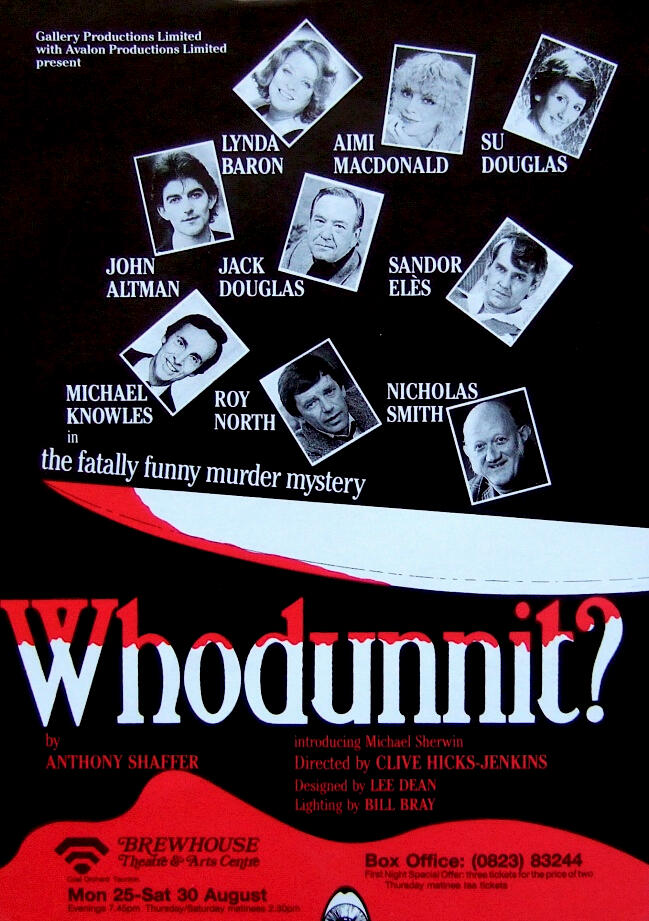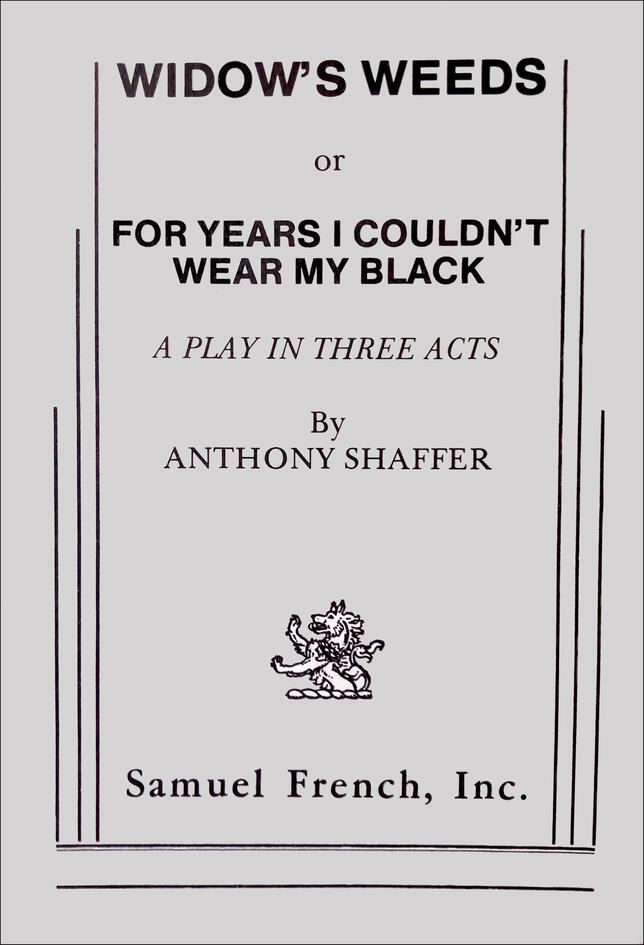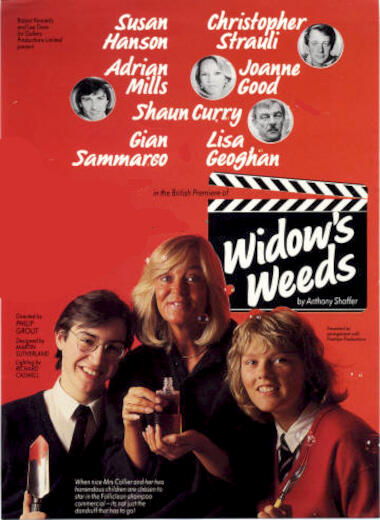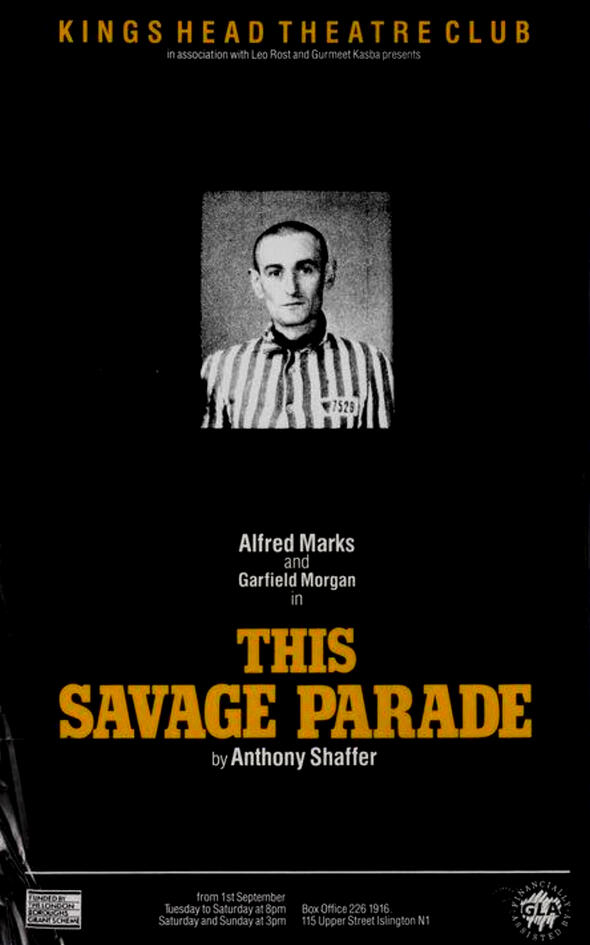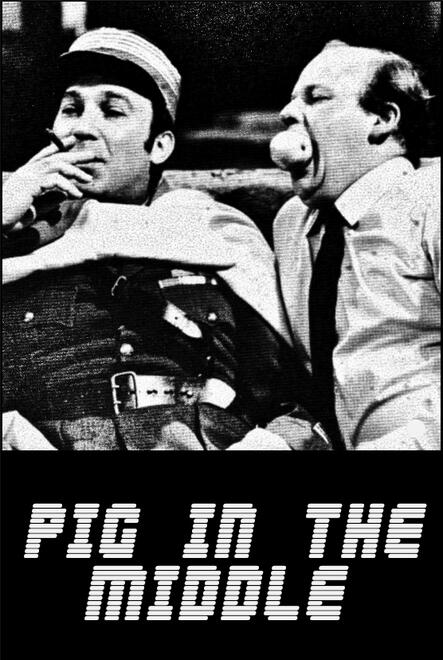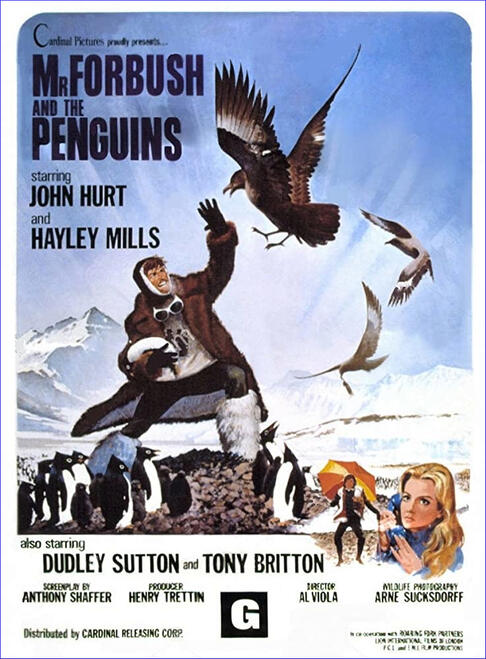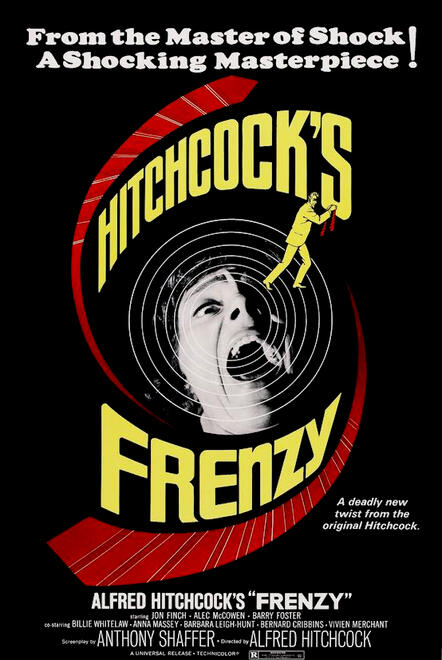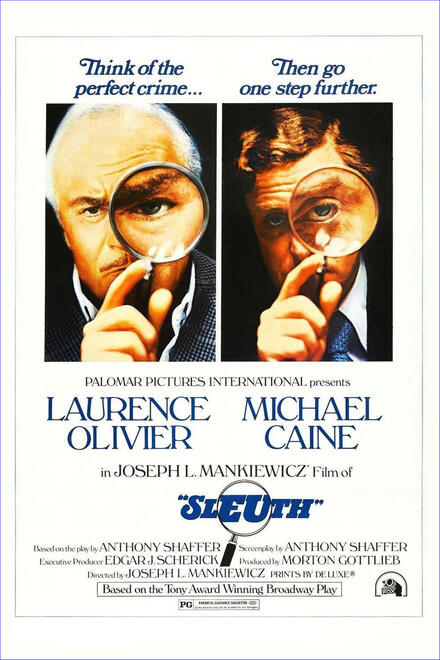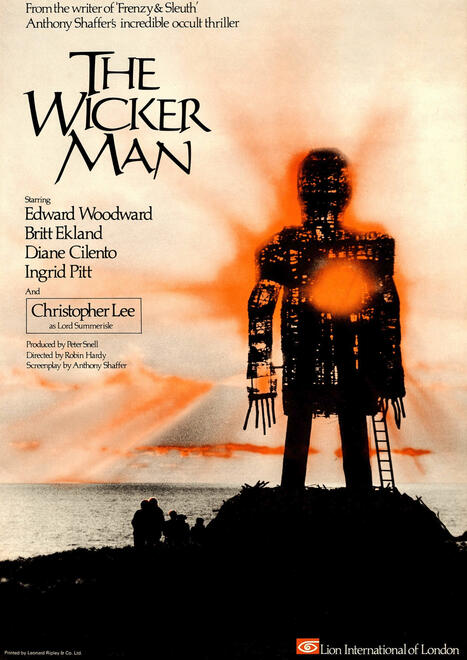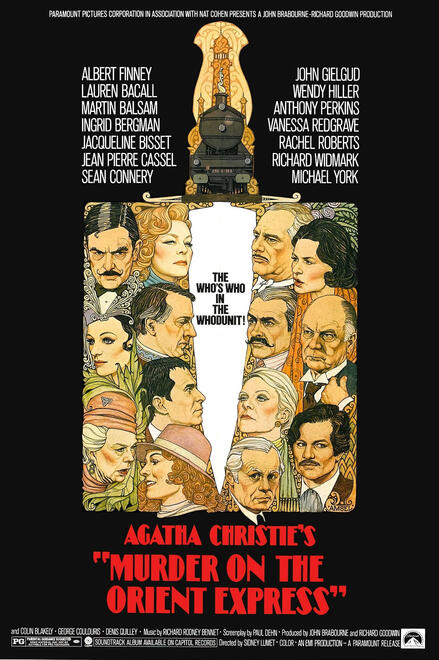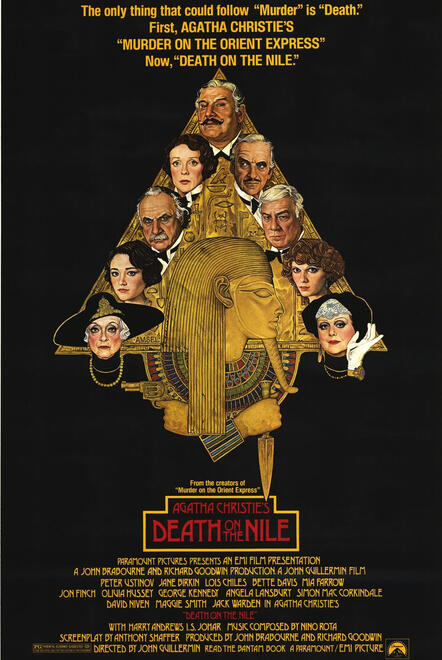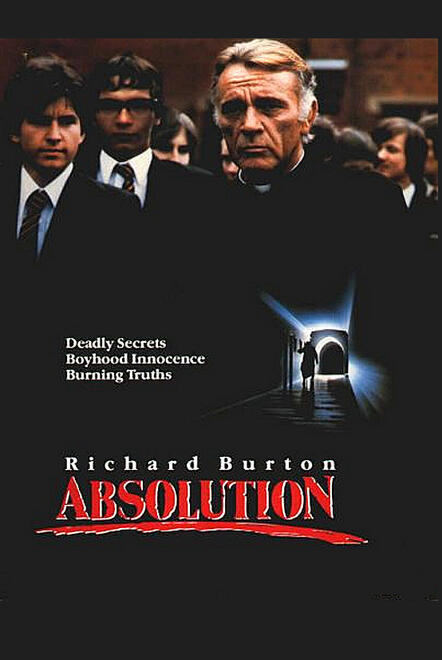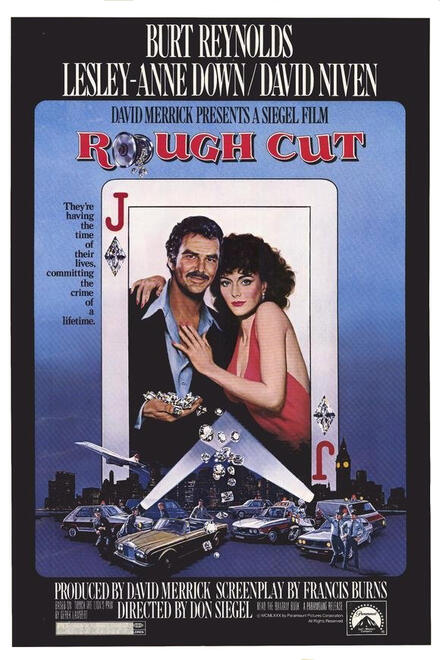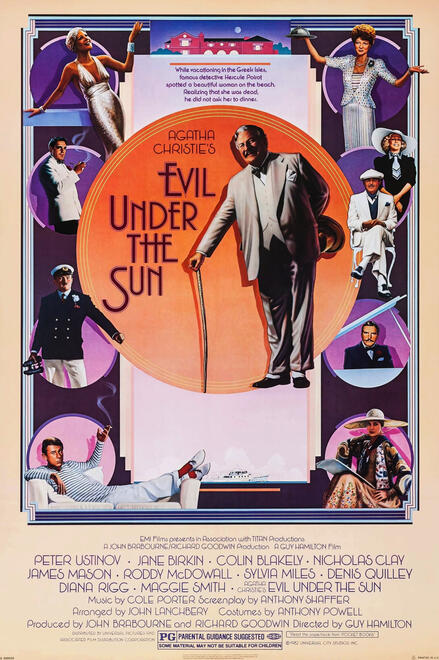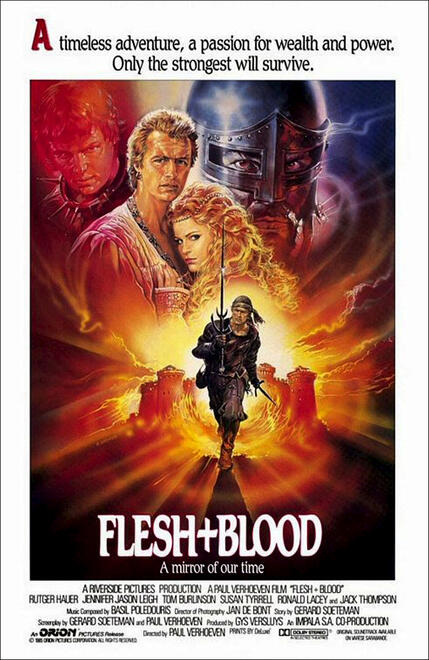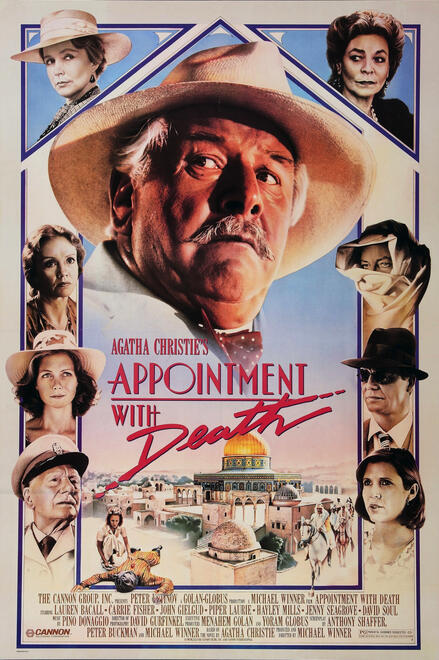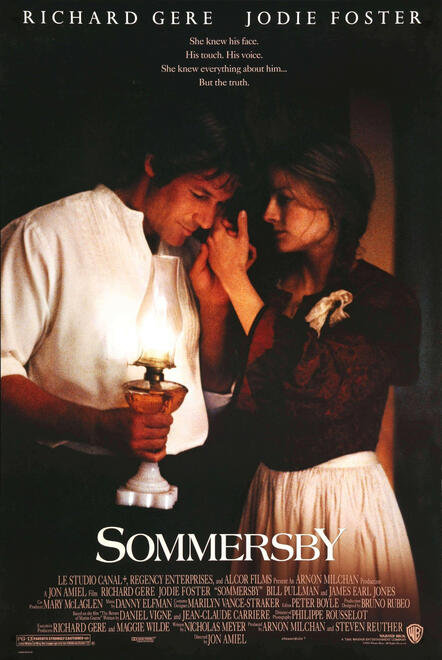Anthony Shaffer
Anthony Shaffer, the distinguished, award-winning playwright, is best known for his masterful contributions to the mystery thriller genre.
His acclaimed play, the twisting thriller, Sleuth, broke box-office records in London and New York, winning him a Tony Award for Best Play and the Edgar Award from the Mystery Writers Of America.
Shaffer also adapted Sleuth for film, which was nominated for several Academy and BAFTA awards, and went on to write several scripts for stage and screen, including Alfred Hitchcock's thriller Frenzy, the cult horror The Wicker Man, as well as adapting several Agatha Christie novels for the big screen.Throughout his career, he demonstrated a unique ability to combine clever narrative and intricate plot twists, blending humour with mystery, leaving a lasting impact on both theatre and film.
About
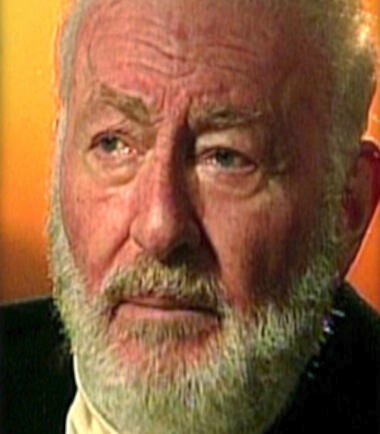
Anthony Joshua Shaffer was born on 15th May 1926 in Liverpool, England, to parents Reka and Jack Shaffer, a property and finance businessman. His identical twin brother, Peter, was born five minutes later, and a younger brother, Brian, was born in 1929.In his memoirs, So What Did You Expect? (Picador, 2001), Anthony recalls growing up in Liverpool and how a visit to the Liverpool Playhouse with their mother sparked their lifelong interest in mystery thrillers and storytelling.In 1936, the family moved to Hampstead, London, but due to the outbreak of World War II, the brothers were evacuated to various locations before settling with their grandparents in Blackpool. Upon leaving school, they were conscripted to work in the coal mines as "Bevin Boys" and were transferred to the Chislet Colliery in Kent.The brothers attended Trinity College, Cambridge, where Anthony studied Law and became editor of Granta, the university's light-hearted publication, and later worked with The Leader magazine. After graduating, Shaffer practiced as a barrister in divorce courts but found the profession unfulfilling and transitioned to a career in television and film advertising.Anthony and Peter collaborated on three detective novels under the pseudonym Peter Antony: The Woman in the Wardrobe (1951), How Doth the Little Crocodile? (1952), and Withered Murder (1955). These novels featured their eccentric detective, Mr. Verity, solving murder mysteries in which Anthony provided the plots while Peter contributed significantly to the writing.They also wrote several pieces for London Mystery Magazine, a quarterly publication specializing in murder mysteries. Anthony became the magazine's resident book reviewer, critiquing numerous titles with wit and insight, reflecting his deep knowledge of the genre.In the mid-1950s, he worked at Pearl and Dean, writing and producing commercials for television and film before moving on to the Film Producers Guild and then to Television Advertising. Through his work in advertising, he met Robin Hardy, and together they founded their own advertising agency, Hardy, Shaffer & Associates. Shaffer married model Carolyn Soley, with whom he had two daughters, Claudia and Cressida.The early 1960s saw Shaffer's first play, The Savage Parade, a drama based on the Eichmann trials, first presented at The Globe Theatre, London, and later at the Lyceum Theatre, Crewe. His first work for television, a half-hour drama called Pig in the Middle, was aired by HTV in 1969, and later that year, he adapted Graham Billings's novel Forbush and the Penguins into a film.By this time, Peter had established himself as an award-winning playwright, with his first play, The Salt Land, being televised in 1955, marking the beginning of a prolific career. He gained widespread acclaim with Five Finger Exercise, which won both the Evening Standard Drama Award and the New York Drama Critics' Circle Award.Other notable works for stage and screen include The Royal Hunt of the Sun, Black Comedy, The Private Ear, and The Public Eye. His plays Equus and Amadeus were adapted into award-winning films; Amadeus won eight Academy Awards, including Best Picture and Best Adapted Screenplay for Peter Shaffer.Anthony's twisting thriller, Sleuth, premiered on 12th January 1970, at the Theatre Royal in Brighton before transferring to London’s West End, where it ran for five years to critical acclaim. Sleuth transferred to Broadway, where it played for three years before touring extensively in the UK and US with numerous revivals over the decades.The success of Sleuth led to Shaffer working with Alfred Hitchcock on his film Frenzy, a thriller based on Arthur La Bern's novel Goodbye Piccadilly, Farewell Leicester Square.Sleuth was also adapted into a feature film directed by Joseph L. Mankiewicz, starring Laurence Olivier and Michael Caine. The film received several Academy Awards and BAFTA nominations and earned Shaffer the Tony Award for Best Play in 1971 and the Edgar Award from the Mystery Writers of America.The Wicker Man followed, being released in 1973 as a B-movie alongside Nicolas Roeg’s Don’t Look Now. However, it was quickly forgotten until a revival some years later gained it a reputation as a cult movie. Shaffer also met his third wife, Diane Cilento, during the filming of The Wicker Man.Having contributed to Sidney Lumet’s film of Agatha Christie's Murder on the Orient Express (1974), Shaffer was invited by the producers to adapt other Christie novels for film. His adaptations of Death on the Nile (1978) and Evil Under the Sun (1982), both lavish productions starring Peter Ustinov as Hercule Poirot, proved to be hits with audiences and critics. Another Christie adaptation, Appointment with Death, wouldn’t appear until 1988, though it was based on an earlier Shaffer script.The twisting thriller Murderer played at the Garrick Theatre, London, during 1975, and other plays soon followed, including the comedy-thriller For Years I Couldn't Wear My Black and a parody of Agatha Christie-style mysteries, The Case of the Oily Levantine. Like Sleuth, these would go on to have a number of revivals and tours under the new titles of Widows Weeds and Whodunnit?, respectively. His first play, The Savage Parade, was also revised and produced as This Savage Parade.Shaffer and Diane Cilento developed a home in North Queensland, Australia, which included a retreat for artists, writers, and musicians. They married in the grounds of their home in 1985 and built the Karnak Playhouse, an open-air amphitheatre that hosted various productions of theatre, music, and dance. The venue became renowned for its unique rainforest setting and cultural significance.In May 2001, Shaffer’s play, The Thing in the Wheelchair, premiered at the Karnak Playhouse, directed by Diane Cilento. This would be Shaffer's final work before his death.Anthony Shaffer died of a heart attack on 6th November 2001, at his home in London. He was 75 years old.
Books
The Woman In The Wardrobe
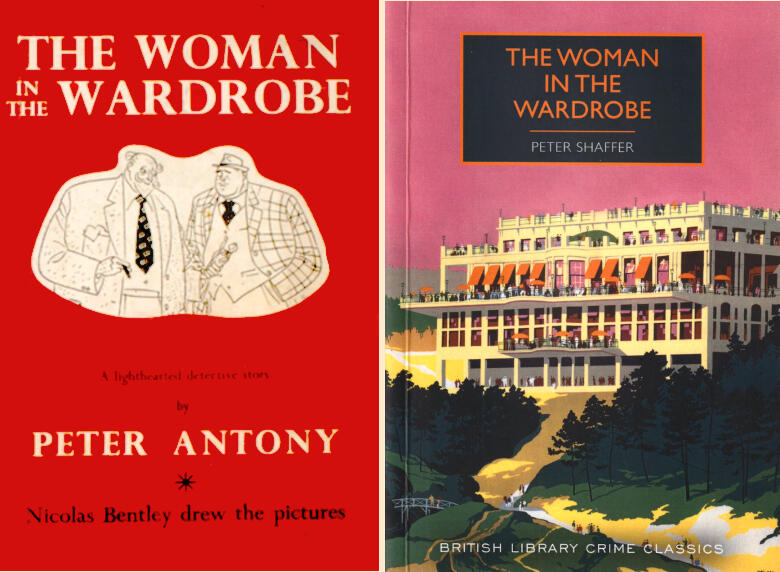
| Publisher | Year |
|---|---|
| Evans Brothers, London (as Peter Antony) | 1951 |
| The British Library, London (as Peter Shaffer) | 2020 |
NOTE: The Woman In The Wardrobe was written by Peter Shaffer, but assisted with the plot by Anthony. This arrangement would continue with the young Shaffer brothers collaborating on two further murder mystery novels featuring their detective, Mr Verity. The Woman In The Wardrobe is included here as an important, first part of the trilogy.
All is not well in the sunny seaside town of Amnestie when Mr. Verity, out for a walk, sees a man climbing out of a window of the Charter Hotel. He stops and watches as the man moves along the balcony and climbs back in through the next window.
Puzzled, Mr. Verity calls in at the Charter Hotel and speaks to the manageress to report what he's just seen. As he's talking to her, a man hurries down the stairs calling out for help and informs them one of the guests, a Mr. Maxwell, has been found dead in his room. They return to the room, only to find the door is now locked from the inside.
Mr. Verity, a noted figure in the world of detection, loud and with questionable ethics (and disliked by Scotland Yard as he's often right), soon finds himself dealing with an array of suspicious guests at the hotel, a maid bound and gagged in a wardrobe next to the body of the dead man, and the eccentric Mr. Tudor, whose wild claims and eventual disappearance only add to the mystery.
How Doth The Little Crocodile?
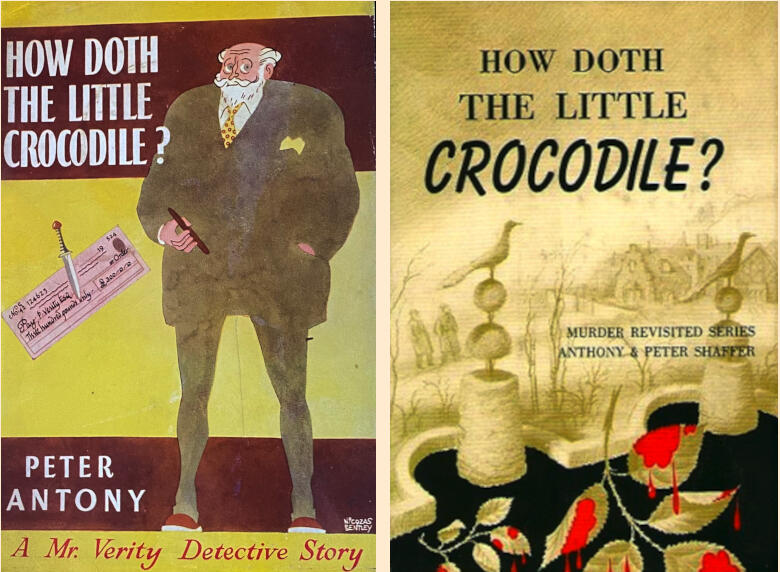
| Publisher | Year |
|---|---|
| Evans Brothers, London (as Peter Antony) | 1952 |
| MacMillan, US (as Anthony & Peter Shaffer) | 1957 |
The US edition was reprinted as a MacMillan ‘Cock Robin Mystery’ book. How Doth The Little Crocodile? was book number 16 of the “Murder Revisited Series.”NOTE: Mr Verity is known as Mr Fathom in the US edition.Mr. Verity takes on the case of Roger Hope, a man who had stood trial for the murder of retired judge Sir Derek Livingstone. He was later acquitted due to late evidence that proved his innocence.
Roger Hope, a member of the De Quincey's Society of Connoisseurs in Murder club, wrote to the other members, informing them he knew the identity of the real murderer, which he would reveal at their next meeting. However, before this meeting took place, Roger Hope was struck by a car and killed.
Mr. Verity, himself a member of the connoisseurs' club, had also received the same letter sent to his fellow club members. He finds himself in Allsop, Sussex, investigating Roger Hope's suspicious death and his claims about the identity of Sir Derek Livingstone's real murderer.
Working his way through a variety list of suspects, Mr. Verity finds they all had motives for killing Derek Livingstone, and all had left clues in doing so. However, the truth concerning Roger Hope and his untimely death is even more puzzling, and Mr. Verity's revelations at the conclusion leave the guests of the murder club shocked and amazed.
Withered Murder
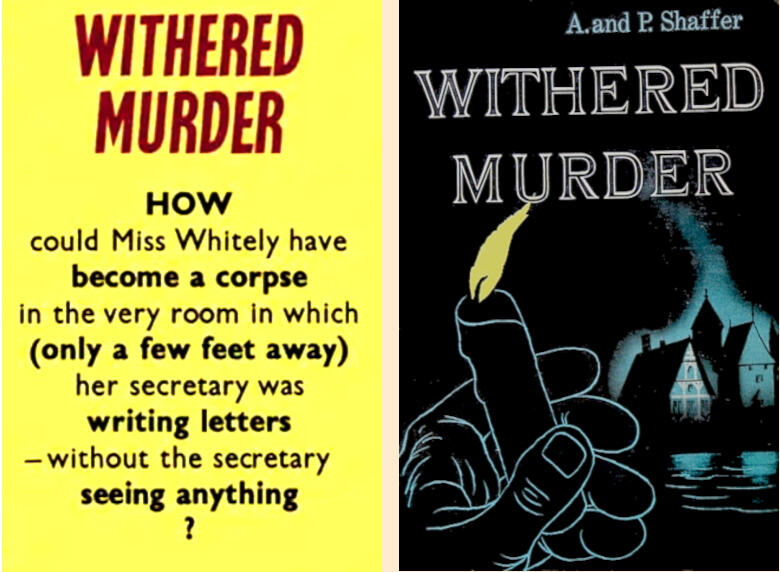
| Publisher | Year |
|---|---|
| Victor Gollancz, London (as A & P Shaffer) | 1955 |
| MacMillan, US (as A. and P. Shaffer) | 1956 |
NOTE: Mr Verity is known as Mr Fathom in the US edition.Mr Verity is staying at the Barnacle Hotel at Crab Point, a small island off the Cornish coast. He is there to visit Captain Trelawney, who has two primitive terra-cotta statues from Corinth, which he would be interested in acquiring.
During his stay at the hotel, Mr Verity senses tension among some of the other guests and learns there has been a troubled history between them.
He observes them over dinner one evening and regards each of them carefully: the proprietress; the retired actress; the secretary; the ex-husband and a failed artist; a professor; a minister and his wife; a young journalist; a solicitor and an archaeologist and ancient historian.
Returning from a visit to the theatre on the mainland to see a production of Macbeth, Mr Verity and the other guests arrive at the Barnacle Hotel to discover the lifeless body of Celia Whitely, the retired actress. It’s apparent she has been murdered in a gruesome attack.
Mr Verity takes charge and begins his investigation. He finds the old lady’s Will, and questions each of the guests and staff in turn, his suspicions and accusations upsetting them in the process. He digs deeper into their backgrounds and finds they all have a motive for the murder in some form. When he goes to question Hilary Stanton, Celia Whitely’s secretary, he finds her hanging from the ceiling. Nearby is a suicide note in which she confesses to killing Celia Whitely.
However, Mr Verity has suspicions about Hilary Stanton's death and her written confession. He gathers the guests to reveal an unexpected twist, which itself leads to another sudden, shocking death.
The Wicker Man

1978

1979

1979

2000
| Publisher | Year |
|---|---|
| Crown Publishers, New York | 1978 |
| Hamlyn, UK | 1979 |
| Simon & Schuster, New York | 1979 |
| Hamlyn, UK | 1980 |
| Pan Books / Macmillan, UK | 2000 |
| Crown / Three Rivers Press, New York | 2006 |
| Pan Macmillan / Tor, UK | 2014 |
Robin Hardy and Anthony Shaffer's novelisation of their film was first published some five years after the film's release, and takes us much deeper into the story of Sergeant Howie's search for the missing child, Rowan Morrison. The book takes us on a detailed tour of Summerisle, revealing more about the people who live there and their religious beliefs and practices.
The pious Sergeant Howie is now younger than his screen counterpart, and we learn more about him as a person, his views on life, nature, and his work as a police officer. Again, we see things from his point of view as events on the island begin to unfold.
Some of the missing scenes and dialogue from Shaffer's original script have been restored, and a number of characters which are only hinted at briefly in the film are now brought to life. These characters add more insight into the ways of the community and life on the island, which was sadly missing in the film.
In the early chapters, we meet Mary Bannock, Sergeant Howie's fiancée, who originally appears briefly in a non-speaking role. She is now an important part of the story as we learn about her relationship with Sergeant Howie and the things that are important to them both. She is also the subject of reflection while Sergeant Howie is away on the island.
Other characters who were unknown to us before include the gillie with her horse and cart who takes Sergeant Howie to visit Lord Summerisle. We also encounter her brother Beech, a sad, lonely figure who lives a remote life in the woods, believing he's a king, guarding a sacred grove. The gillie visits him with food each day, believing in Lord Summerisle's word that her brother can be cured.
The novelisation reads like a restoration of the film with all the extra pieces fitting neatly together, a film we are now unlikely to see.
Absolution

1979

1979

1994

2017
| Publisher | Year |
|---|---|
| Corgi, London | 1979 |
| Severn House Publishers, London | 1979 |
| Rivages (French Edition) | 1992 |
| Rivages (French Edition) | 1994 |
| Rivages (French Edition) | 2017 |
The novelisation of Absolution was released as a tie-in for the film, which had been shot a year earlier but was still awaiting distribution for general release. Shaffer's book reveals more of the inner conflicts of the Catholic religion, and we witness the torment and despair this brings among the three main characters: Father Goddard, Benji, and Arthur. The book also contains some major differences from the film, with new scenes and dialogue, some new faces, and a completely different ending unique to the novel.
We learn that Father Goddard had once worked as a missionary in Africa when he was younger, and that Benji's father had left his mother when Benji was a child. Father Goddard becomes a more paternal figure to him here, which causes some hostility with the other boys. However, Father Goddard retains his cold, hard manner, particularly towards Arthur, as he does in the original script and film.
The novel reveals more about Benji's friendship with Blakey, the traveling biker who has camped in a nearby wood. This friendship grew after Benji found Blakey stealing food from the school kitchen. Initially, Benji chases after him across the school grounds where they have a scuffle, but Benji lets him go. Later, sitting around the campfire, Blakey talks of his past and how he became a traveller, all of which intrigues the young student. The book also retains a scene from Shaffer's script where the boys in Benji's dorm warn him about seeing Blakey, as he might bring trouble for them all - a warning Benji ignores.
Other differences include a scene where Father Goddard talks to his class about confession, which now takes place at the breakfast table instead of in the classroom. He also takes his pupils to the chapel to visit the confessional to familiarise them with it. The lesson with the boys translating the texts of "Caesar's Gallic Wars" is much longer in the book. First, Father Goddard humiliates Arthur for not being able to translate a simple text, and then he is infuriated by Benji for translating the text in modern-day slang. Father Goddard puts them both on detention for this. This class is also joined by the elderly deputy Father Rivers, who sits in with the boys to see how they are progressing. This part of the book then goes into the scene from the film where Arthur talks about siege ramps and is bellowed at by Father Goddard for pushing for a discussion on Roman strategy.
The final chapter includes an extended scene where Arthur emerges from the shadows of the chapel, to find the tormented Father Goddard praying at the altar. An epilogue which is set some years later, brings about a new ending.
So What Did You Expect?
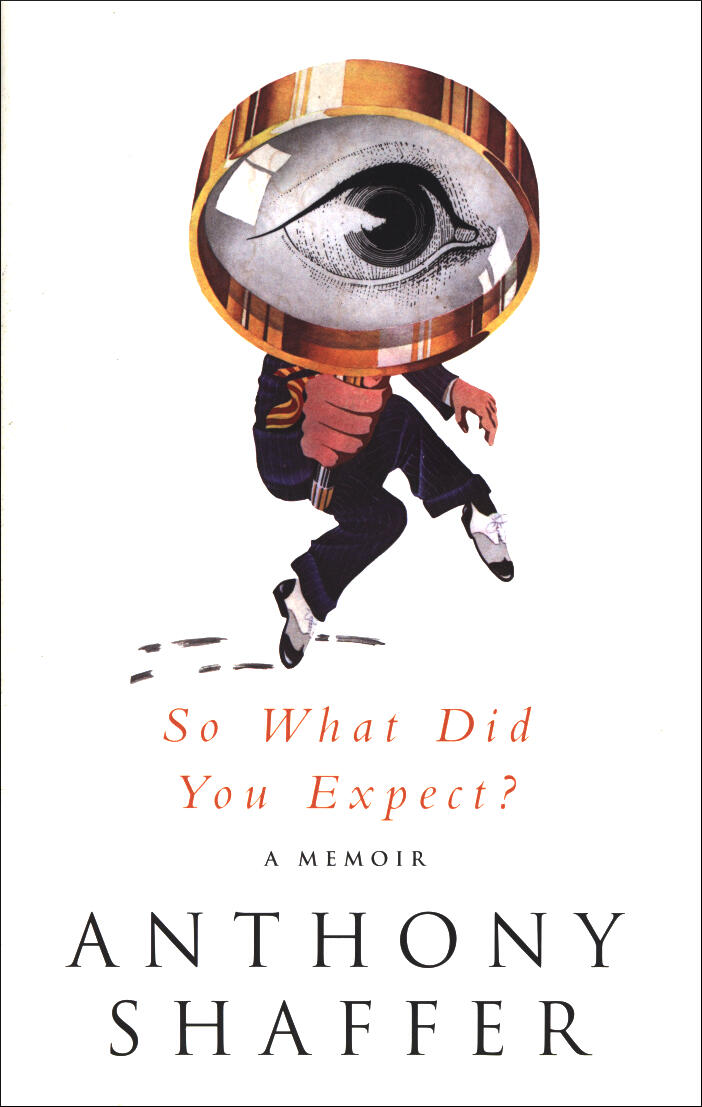
| Publisher | Year |
|---|---|
| Picador, London | 2001 |
Anthony Shaffer's memoir offers a compelling and often humorous account of his life and career. The book takes readers on a journey of Shaffer's early beginnings of life in Liverpool with twin brother Peter, his first taste of theatre, evacuation during World War II and anecdotes about education and love of games and practical jokes.
The memoir covers Shaffer's early crime writing days with Peter, his brief foray into Law, and becoming a writer and producer in film and television advertising, before his eventual success as a playwright.
Shaffer shares anecdotes about his interactions with notable figures in the entertainment industry and relationships with producers, directors and actors, including his close collaborations with Alfred Hitchcock and Joseph L. Mankiewicz. The book provides insights into the theatre world and Shaffer's contributions, such as his role in transferring Agatha Christie's The Mousetrap to its long-standing theatre location.
So What Did You Expect? showcases Shaffer's wit and storytelling abilities, making it an engaging read for those interested in the life of this celebrated playwright and offers a glimpse into a bygone era of British theatre and serves as a work of social and personal history.
Stage Plays
Sleuth

Eary Edition
Script Cover
1970

1990

1992

2008

2024
Andrew Wyke, a best-selling author of detective fiction, invites Milo Tindle to his lavish manor. We discover that Milo has been having an affair with Andrew’s wife, Marguerite.
As they discuss Milo's plans to marry Marguerite, Andrew reveals his indifference toward their marriage and is more than happy to let her go as their marriage is not a loving one and, Andrew himself has a mistress, a younger woman called Tia.
Knowing that Milo won’t be able to afford to keep Marguerite in the lifestyle she has been accustomed, he proposes a scheme: Milo should steal a collection of valuable jewellery intended for Marguerite, sell it, and use the money to support her. He tells him that he should steal the jewellery that night while Marguerite is away, sell it on to a fence (one known and arranged by Andrew) and live with Marguerite happily ever after, while Andrew claims on the insurance and settles down with Tia.
To avoid leaving clues, Andrew has Milo disguised as a clown and instructs him on breaking in through a window, ransacking the house and blowing up the safe where the jewels are kept. However, Andrew reveals a darker motive - he threatens Milo with a gun, revealing that the robbery had been set up to frame him as a burglar and is about to kill him in cold blood. Milo, realising he has no way out or means of escape, begs for his life.
Later, Inspector Doppler arrives to investigate Milo's disappearance. Andrew insists he hasn't seen Milo recently, but evidence points to foul play. The detective finds a bullet hole in the wall, blood on the stair carpet, and a mound of freshly dug earth laid in a flower bed in the garden.
The twist unfolds as a game of revenge takes shape through mind games and deception, culminating in a thrilling battle of wits and survival.
1970 - 1975
Shaffer's thriller opened on the 12th January 1970 at the Theatre Royal, Brighton before transferring to the following London venues: St Martins (12th February 1970) Garrick Theatre (March 1973) and the Fortune Theatre (October 1975.) This five year run played for 2,359 performances to rave reviews, citing Sleuth as rewriting the modern day thriller, with its ingenius plot, unexpected twists and dark humour.
“A clever and enjoyable piece full of energy, sophistication and brilliant humour.” – The London Theatre Guide.During this time, Shaffer won a Tony Award for Best Play at the Antoinette Perry Awards, held at The Palace Theatre, New York on 28th March 1971 and a month later received the Edgar Award on 29th April 1971 from the Mystery Writers Of America.
Cast:
| Andrew Wyke | Anthony Quayle |
| Milo Tindle | Keith Baxter |
| Inspector Doppler | Stanley Rushton |
| Det. Sgt. Tarrant | Robin Mayfield |
| P.C Higgs | Liam McNulty |
Director: Clifford Williams
Design: Carl Toms
Other names who took roles during this five year run in London include: Paul Rogers, Donal Donnelly, Marius Goring, John Fraser, Anthony Valentine, Michael Allinson, Del Henney, Raymond Westwell, Christopher Reich, Gary Waldhorn and David Bradley.
The play also saw a number of revivals over the years, many touring the UK with established and household names such as Nigel Davenport, Tony Anholt, Donald Pickering, Mark Arden, Peter Bowles, Michael Maloney, Ian Ogilvy, Simon MacCorkindale, Michael Praed and more recently, Todd Bryce and Neil McDermott.
Broadway & Elsewhere
The growing success of Sleuth at the West End meant a transfer to New York's Broadway was inevitable and, on the 12th November 1970, Sleuth opened at the Music Box Theatre where it ran for 1,222 performances for three years before closing on 13th October 1973.
On the 5th April 1973, the New York Times reported that Sleuth had reached 1,000 performances at the Music Box theatre the night before, making it the longest running show on Broadway at that time. It added that the only other play to reach 1,000 performances in London and Broadway was Joseph Kesselring's Arsenic And Old Lace.
“Clever, intricate…It is good, neat, clean and bloody fun.” – The New York Times.
Again, Anthony Quayle and Keith Baxter took the lead roles, and were replaced over time by Paul Rogers, George Rose, Brian Murray, Patrick Macnee, Donal Donnelly, Jordan Christopher and Curt Dawson.
Of these, Patrick Macnee would remain with the production the longest, playing the part of Andrew Wyke from July 1972 to the end of its run at the Music box theatre and then becoming part of the touring production which made its way around the U.S until 1975.Sleuth also became a hit around the world and continues to have an international following with productions covering Europe, Asia and Australia which play to large audiences.

U.S
1970
Greece
1971
Germany
1986
Italy
2011
Japan
Year Unknown
Murderer

Script Cover

Original Poster For
1975 Production
2004
Norman Bartholomew, a painter with a dark obsession, meticulously plans and executes the murder of his subject, Millie Sykes. He strangles her, dismembers her body, and disposes of the remains in his stove, all while maintaining an eerie calm.
When Sergeant Stenning arrives to investigate a neighbour’s report, Norman engages in a psychological game, deflecting suspicion with dark humour and odd behaviour. Sergeant Stenning conducts a search of the house and finds a smouldering head in the wood burner stove. Quickly realising the head is a fake, he demands an explanation. Norman reveals his hobby of re-enacting famous murder cases, claiming it's all part of experiencing the thrill of being a murder suspect.
Norman and Millie, who we learn has been a willing victim in Noman’s game, perform disturbing theatrical scenarios in front of Sergeant Stenning, leaving him frustrated and confused. He tries, without success, to warn them of the games they are playing, and leaves the house to put the neighbour’s mind at ease.
However, we learn the game Norman had set up for Sergeant Stenning was part of his true intentions: to murder his wife, Elizabeth.
Elizabeth arrives home early to find Norman with Millie and confronts him about his affair, revealing to Millie that she knows about Norman’s role-playing and fantasies of murder, and the other women he has been seeing. Millie leaves, upset that Norman had been using her.
As tensions rise, Norman and Elizabeth engage in a dangerous game of cat and mouse, with each trying to outsmart the other. The situation escalates, and Norman attempts to carry out his murderous plan.
Just when it seems Norman has succeeded, Sergeant Stenning returns unexpectedly, and the atmosphere grows thick with suspicion as the plot rapidly moves in new directions and the characters’ true motives and actions come to light.
1975
Murderer opened at the Theatre Royal, Brighton on the 11th February 1975 before moving on to the Theatre Royal, Newcastle (24th February - 1st March) and the Lyceum Theatre, Edinburgh (3rd - 8th March) before finally transferring to the Garrick Theatre, London on 12th March, where it played until 19th July 1975.
Cast:
| Norman Bartholomew | Robert Stephens |
| Millie Sykes | Patricia Quinn |
| Sergeant Stenning | Warren Clarke |
| Elizabeth Bartholomew | Caroline Blakiston |
Director: Clifford Williams
Design: Carl Toms
1992
Shaffer wrote several versions of Murderer over the years, each having different scenes and endings, though the premise of Norman planning to kill his wife remains in each. He also wrote a new version which was presented at the Karnak Playhouse Theatre in the grounds of Karnak, the home he shared with Diane Cilento in North Queensland, Australia. This production was part of the opening ceremony of the Karnak Playhouse on the 9th August 1992, though the actual opening was on the previous night, itself a glamorous occasion with music, dancers and other live performance. Murderer was a special presentation for the invited audience and had been adapted for the occasion.
The play ran from the 9th August - 6th September 1992.
Cast:
| Norman Bartholomew | John Stanton |
| Millie Sykes | Justine Clarke |
| Sergeant Stenning | Steven Grives |
| Elizabeth Bartholomew | Jane Harders |
Director: Diane Cilento
Design: James Ridewood
2004
A brief revival saw Murderer play at the Menier Chocolate Factory in Southwark, London from 10th November 2004 – 22nd January 2005, with Les Dennis taking the lead role of Norman Bartholomew.
Cast:
| Norman Bartholomew | Les Dennis |
| Millie Sykes | Lisa Kay |
| Sergeant Stenning | George Potts |
| Elizabeth Bartholomew | Caroline Langrishe |
Director: Adam Speers
Design: Simon Scullion
The Case Of The Oily Levantine / Whodunnit?

1977

1979

1982 (U.S)

1986
The play opens in the lavish library of Orcas Champflower Manor, an 18th-century estate with towering bookcases. A chilling taped message from an anonymous murderer greets the audience, confessing to the crime and challenging them to uncover clues throughout the performance.
Andreas Capodistriou, a cunning blackmailer, manipulates guests at Silas Bazeby's manor during a weekend retreat. He exposes dark secrets of each guest, including Perkins the butler, Silas Bazeby, Rear Admiral Knatchbull-Folliatt, Lady Tremurrain, and Dame Edith Runcible, demanding payment for silence. Capodistriou's threats intensify as he reveals Lavinia Hargreaves's past affair with him.
As dinner approaches, tension mounts. While Capodistriou prays alone, the guests conspire. In a shocking turn, they collectively ambush him, resulting in his decapitation during a thunderstorm.
Inspector Bowden and Sergeant Standish are investigating the murder. A startling revelation emerges: Capodistriou was actually Gerry Marshall, the guests' agent who had orchestrated their stay as a murder mystery performance for Mr. Bazeby's birthday. Each guest is revealed to be an actor playing a stereotypical role.
The investigation takes another turn when Mr. Bazeby is found murdered similarly to Capodistriou, and events unfold which blur the lines between performance and reality.
1977
The Case Of The Oily Levantine was presented by the Yvonne Arnaud Theatre, Guildford from the 1st - 19th November 1977.
Cast:
| Archibald Perkins | Geoffrey Palmer |
| Andreas Capodistriou | George Cole |
| Silas Bazeby | Dudley Jones |
| Rear Admiral Knatchbull Folliatt | Geoffrey Lumsden |
| Lady Tremurrain | Fenella Fielding |
| Lavinia Hargreaves | Liza Goddard |
| Roger Dashwell | David Robb |
| Dame Edith Runcible | Gwen Nelson |
| Insector Fathom | George Cole |
| Sergeant | Roger Leach |
Director: Val May
Design: Hayden Griffin
1979
The play went into production two years later opening at the Richmond Theatre, London from 6th - 11th August 1979, then taking in dates at Brighton, Bath, Norwich and Her Majesty's Theatre, London from 13th September - 3rd November 1979.
This production was made up of a new cast, though Gwen Nelson and Roger Leach return to their previous roles.
Cast:
| Archibald Perkins | Wolfe Morris |
| Andreas Capodistriou | Hywel Bennett |
| Silas Bazeby | Bernard Archard |
| Rear Admiral Knatchbull Folliatt | William Squire |
| Lady Tremurrain | Anna Quayle |
| Lavinia Hargreaves | Adrienne Posta |
| Roger Dashwell | Paul Angelis |
| Dame Edith Runcible | Gwen Nelson |
| Sergeant | Roger Leach |
Director: Patrick Dromgoole
Design: Hayden Griffin
1982 / 1983
The Case Of The Oily Levantine was, again, revised by Shaffer and opened at the Biltmore Theatre in New York on 30th December 1982 as Whodunnit where it played until 15th May 1983.
Cast:
| Archibald Perkins | Gordon Chater |
| Andreas Capodistriou | George Hearn |
| Silas Bazeby | Jerome Dempsey |
| Rear Admiral Knatchbull Folliatt | Ronald Drake |
| Lady Tremurrain | Barbara Baxley |
| Lavinia Hargreaves | Lauren Thompson |
| Roger Dashwell | John Glover |
| Dame Edith Runcible | Hermione Baddeley |
| Insector Bowden | Fred Gwynne |
| Sergeant | Jeffrey Alan Chandler |
Director: Michael Kahn
Design: Andrew Jackness
1986 / 1987
In 1986, Whodunnit? (as it was now billed) made an extensive tour of the UK with a cast of well-known faces from British television.
The tour opened at the Brewhouse Theatre, Taunton from 25th - 30th August and moved on to Glasgow, Cambridge, Brighton, Oxford, Hull, Darlington, Swindon, Birmingham, Croydon, Edinburgh, Bath, Horsham before stopping at Aberdeen where it ran from 25th – 29th November.
The play then continued to tour in the early months of 1987, taking in Dartford, Redhill, Peterborough, Poole, Eastbourne, Lincoln, Chesterfield, Ayr, Stevenage and then ending its run at the Marlowe Theatre, Canterbury (20th – 25th April)
This part of the tour retained most of the cast, who were joined by other television stars along the way, including Madge Hindle, Zeph Gladstone, Bernie Winters and Su Douglas.
Cast:
| Archibald Perkins | Michael Knowles |
| Andreas Capodistriou | Sandor Eles |
| Silas Bazeby | Roy North |
| Rear Admiral Knatchbull Folliatt | Jack Douglas |
| Lady Tremurrain | Su Douglas |
| Lavinia Hargreaves | Aimi MacDonald |
| Roger Dashwell | John Altman |
| Dame Edith Runcible | Lynda Baron |
| Inspector Bowden | Nicholas Smith |
| Sergeant Standish | Michael Sherwin |
Director: Clive Hicks Jenkins
Director: Philip Grout (1987 dates)
Design: Lee Dean
Widow's Weeds / For Years I Couldn't Wear My Black

Script Cover

1986
This comedy thriller begins with Mrs. Collier, visibly anxious, adjusting her makeup and fluffing cushions as a small film crew arrives to shoot a commercial for Folliclean, a new shampoo. Director Dick Richards spots a photo of her children and suggests including them in the ad, a notion that makes Mrs. Collier uncomfortable, especially since she fears the crew may still be present when her kids return from school. The crew finds her behaviour odd but continues their preparations.
After several false starts and some crew disputes, filming finally commences, interrupted by Mrs. Collier’s son, Reginald, who bursts in wearing a panther costume, startling everyone. He claims to have killed his father, while his sister Christine argues that she was the one responsible. Embarrassed yet unable to intervene, Mrs. Collier joins in, revealing her complicity in their father's demise.
As the crew debates whether to notify the police, Mrs. Collier convinces them it’s merely a game. Mr. Younghusband, the shampoo company's owner, arrives and insists on featuring Mrs. Collier and her children in the commercial, believing families sell well on screen. Despite Dick and Philip's reservations about the family’s background, they agree to Mr. Younghusband's vision for the ad.
When Mr. Collier unexpectedly returns home early from a business trip, he is initially displeased with the filming but reluctantly agrees to participate for payment. The crew quickly films him alongside Mrs. Collier and the children before packing up.
Once alone, Mr. Collier reveals his harsh demeanour as he berates his children and takes Mrs. Collier's share of the earnings. He imposes strict punishments on them for their supposed lies about killing him. In a shocking twist, Mrs. Collier confesses that their claims were true—Reginald and Christine had indeed killed their father.
Just as tensions rise and revelations unfold, a sudden knock at the door interrupts the charged atmosphere...
1977
In the early 1970's, the press reported a new script by Shaffer, a comedy thriller, called Widow's Weeds, had been completed and was planned to go into production. However, this didn't go ahead and, over the next few years, Shaffer worked on the script again, finding it a new home with the Queensland Theatre Company at the SGIO Theatre in Brisbane, Australia.
Widow's Weeds became For Years I Couldn't Wear My Black and ran from 9th February - 26th February 1977.
Cast:
| Florence Collier | Elaine Lee |
| Claire Parker | Robyn Gurney |
| Dick Richards | Douglas Hedge |
| Reginald | Tom Burlinson |
| Christine | Laurel Burton |
| Mr Younghusband | Joe James |
| Philip Charles | Peter Kowitz |
| Alex | Phil Moye |
| Ted | Bruce Parr |
| Bernie | Russell Newman |
| Joe | Warren Meacham |
| Electrician | Ron Layne |
| Bill | Brian Blain |
Director: Joe MacColum
Design: James Ridewood
1987
In 1987, Gallery Productions (who had toured Shaffer's Whodunnit? the previous year,) put together another cast of famous names from British television, for a short UK tour of the play, now under it's original title, Widow's Weeds.
The play opened at the Brewhouse Theatre in August 1987 before setting off for a three month tour stopping at Guildford, Croydon, Plymouth, Harlow, Lincoln, Cambridge, Darlington, Brighton, Swindon and others.
Cast:
| Mrs Florence Collier | Susan Hanson |
| Claire Parker | Joanne Good |
| Dick Richards | Christopher Strauli |
| Alex | Michael Sherwin |
| Bernie | Jason Salkey |
| Joe | Matthew Tinker |
| Philip Charles | Adrian Mills |
| Reginald | Gian Sammarco |
| Christine | Lisa Geoghan |
| Mr Younghusband | Derek Beard |
| Bill | Shaun Curry |
Director: Philip Grout
Design: Martin Sutherland
This Savage Parade

Script Cover

1987
The play is set in a dimly lit wine cellar in Tel Aviv during 1962, where three judges—Aquaba, Eban, and Ophir—await the arrival of a detained suspect. They have received confirmation that the suspect has been identified as Rudolf Friedrich Bauer, a former Nazi SS officer accused of war crimes. As they express their impatience, the guard Cassellotti enters with the prisoner, De Solto, who initially pleads not guilty.
Aquaba reads the charges against De Solto, revealing his true identity and past. Despite evidence against him, including a photograph in Nazi uniform, De Solto claims he was a cattle farmer. The judges question him about his life and his involvement with Hitler's regime. After thorough questioning, De Solto surprises them by claiming to be Stefan Juvenal, their agent sent to find Bauer.
When Miguel enters, claiming to be De Solto, confusion arises as he possesses the scars identifying him as Bauer. Miguel recounts his harrowing experience as a concentration camp prisoner who was used as a decoy for Bauer. He explains how Bauer orchestrated this deception to escape capture.
As the tension builds and identities blur, a shocking revelation threatens to upend everything the judges thought they knew. The true nature of Aquaba comes into question, leaving the audience to grapple with the complexities of justice, identity, and the long-reaching consequences of war crimes.
1963
The Savage Parade, as it was originally titled, played for one night only by the Repertory Players at The Globe Theatre, London on 17th March 1963.
Cast:
| Jacob Aquaba | Leon Sinden |
| David Eban | John Richmond |
| Carl Ophir | Anthony Marlowe |
| Miguel De Solto | Nigel Stock |
| Ramon Rodriguez | Philip Newman |
| Juan Cassellotti | Conrad Monk |
| Elliul | Peter Brett |
| Gurvey | Leonard Trolley |
| Jose Santyana | Jeffrey Segal |
Director: David Giles
1966
The play came about again in 1966 when it was produced by the resident company at the Lyceum Theatre in Crewe. Joining the repertory cast was actor Robert Russell who had began making a name at that time in theatre and film. This production ran from 1st - 5th November 1966.
Cast:
| Jacob Aquaba | Paul Freeman |
| David Eban | Scott Roberts |
| Carl Ophir | John Berryman |
| Miguel De Solto | Robert Russell |
| Rodriguez | John Malone |
| Cassellotti | Joseph McKeown |
| Elliul | Clive Stanhope |
| Gurvey | Peter Wiseman |
Director: Julian Oldfield
Design: Robin Edwards
1987
In 1987, the play, having undergone further rewrites, and now re-titled This Savage Parade, was presented by the King's Head Theatre Club, London.
The play ran from 7th September - 18th October 1987.
Cast:
| Aquaba | Garfield Morgan |
| Eban | Alan Bennion |
| Ophir | John Bown |
| De Solto | Alfred Marks |
| Miguel | Alan Hewood |
| Cassellotti | Nicholas Hutchinson |
| Elliul | Paddy Navin |
| Gurvey | Derek Smee |
Director: Jonathan Myerson
Design: Gillian Daniell
The Thing In The Wheelchair

Set in the early 1960s, this gripping play unfolds at the home of Janet Millar, a 78-year-old woman paralysed from the neck down. Janet communicates only by blinking, living with her daughter-in-law Stella, an actress, and her son Dennis. The story begins on a spring day, with Stella rehearsing lines from Macbeth while Janet observes from the patio.
As the plot unfolds, a sinister plan emerges. Stella and her lover, Rodney Haggard, conspire to murder Dennis for his life insurance money, planning to stage a gas leak accident. Their scheme is complicated by Janet's presence and the arrival of Rosie, a young neighbor who begins to uncover the truth.
The narrative explores themes of betrayal, manipulation, and power struggles within the family. Stella's facade of care crumbles as she cruelly mocks Janet's helplessness, while Dennis remains oblivious to the danger surrounding him. Tension builds as Stella's erratic behavior intensifies, and she considers eliminating Janet as well.
The arrival of Sergeant Savage causes tension with Stella and Rodney, as he investigates the truth about Dennis' murder, making a discovery that leads to a tense confrontation.
The Thing In The Wheelchair is a melodrama, freely adapted from the short story, Eyes That Watch You by Cornell Woolrich.
Shaffer had worked on the idea for a number of years before completing the script which was then produced at the Karnak Playhouse in the grounds of his Australian home. The play ran from the 18th - 27th May 2001 and would be his final piece of work before his death later that year.
Cast:
| Janet Miller | Buzz Whiting |
| Rosie Thompson | Emma Jackson |
| Stella Miller / Haggard | Kathryn Dunn |
| Rodney Haggard | Rory Williamson |
With: Howard Turner and Russell Wicks
Director: Diane Cilento
Design: Robert Kemp
Screenplays
Pig In The Middle
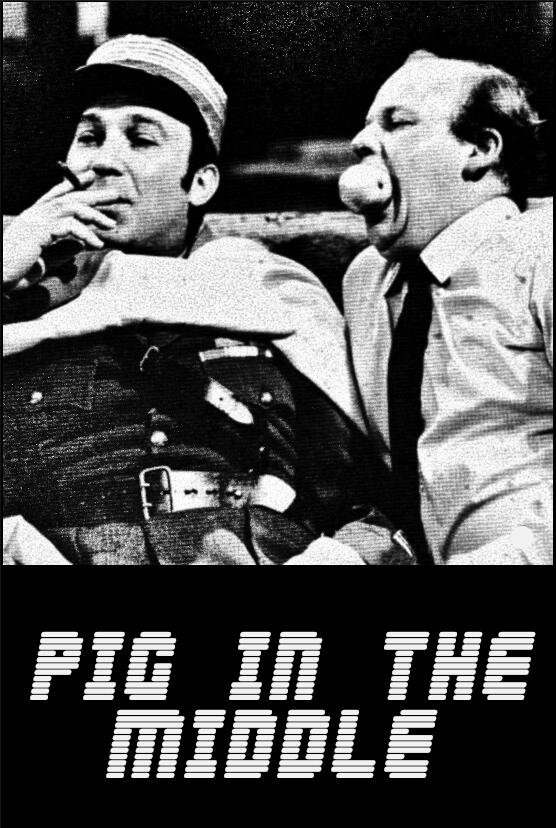
Production Company:
Harlech Television (HTV)
Released:
24th April 1969
(Repeated on 14th August 1969)
Director:
Unknown
Cast:
| Paul St Cloud | Lee Montague |
| Diane St Cloud | Caroline Mortimer |
| Peggy Wigg | Ann Lynn |
| Charles Wigg | Roy Kinnear |
This little known TV drama was first aired by Harlech (HTV) in April 1969 and repeated in August later that year. It had been part of a drama series of half hour episodes HTV had created to showcase different writers and actors.
A game of forfeits is harmless enough, but like many games it can get out of hand.
Set in a cosy, country home when an after-dinner game of forfeits takes a sudden and disconcerting turn. It lays bare emotional rifts and destroys one man’s carefully nurtured world of fantasy.
Mr Forbush And The Penguins
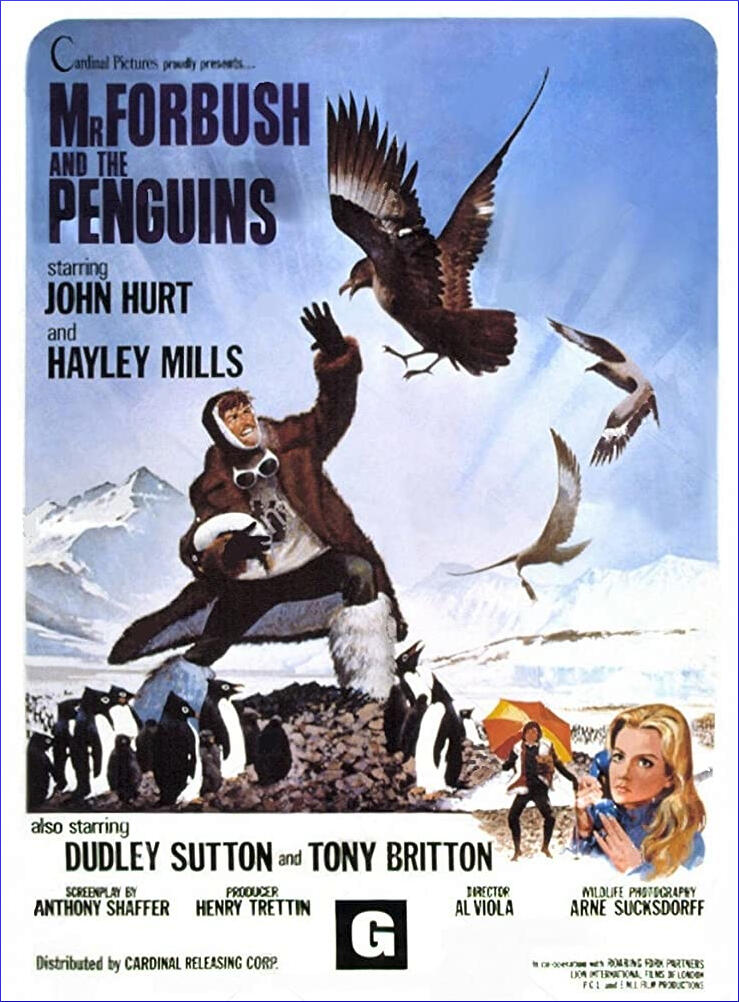
Production Company:
PGL Productions
EMI Films
Released:
30th December 1971 (UK)
1973 (US - as Cry Of The Penguins)
Director:
Al Viola
Roy Boulting (Uncredited)
Arne Sucksdorff (Wildlife Sequences)
Adapted From The Novel:
Forbush And The Penguins (1965)
by Graham Billing
Cast:
| Richard Forbush | John Hurt |
| Tara St John Luke | Hayley Mills |
| Starshot | Dudley Sutton |
| George Dewport | Tony Britton |
| Mr Forbush,Snr | Thorley Walters |
| Mrs Forbush | Judy Campbell |
| Head Of Board | Joss Ackland |
| Fanny | Avril Angers |
| Professor Tringham | Cyril Luckham |
| Jackie | Sally Geeson |
| Ahaz Khan | Salmaan Peer |
| Food Store Assistant | Brian Oulton |
| Police Sergeant | John Comer |
Richard Forbush, a wealthy, carefree and self-absorbed biology student, meets Tara St. John Luke at a cafe-bar. Despite his attempts to charm her, Tara rebuffs his advances. Undeterred, Forbush offers her a ride home, but his miscalculation leads to Tara angrily tossing his car keys from the car, and storming off.
Witnessing this, a policeman intervenes, citing Forbush for illegal parking and conducting a breathalyser test, which he fails. After his release from the local police station, Forbush's tutor, Professor George Dewport, encourages him to attend a lecture on Antarctica. At the lecture, Forbush tries to impress Tara by claiming he'll study crocodiles abroad, only to be caught off guard when his friend Starshot reveals he's heading to Antarctica for research.
Reflecting on his choices, Forbush accepts a job studying Adélie penguins in Antarctica, recommended by Professor Dewport. His parents show little interest in his decision, marking a pivotal moment in Forbush's journey toward self-discovery.
Motivated by his feelings for Tara, Forbush embarks on a six-month Antarctic expedition. At Shackleton's Hut, he finds himself isolated with only a radio and tape recorder to communicate. As winter sets in, Forbush becomes attached to the penguins, observing their struggles against predators like skuas.
During a blizzard, Forbush reflects on the interconnectedness of life and the balance of nature. He learns that even predators play a crucial role in the ecosystem. As he records his experiences for Tara, he begins to understand deeper lessons about survival and coexistence.
Tara, listening to the tapes, begins to realise that Forbush is revealing a caring, sensitive side of himself and is not the person he made himself out to be.
Forbush's transformation culminates in the realisation that all living beings depend on one another, challenging his previous worldview. As he prepares to leave Antarctica and return to Tara, he wonders whether their relationship will endure the changes he has undergone.
Frenzy
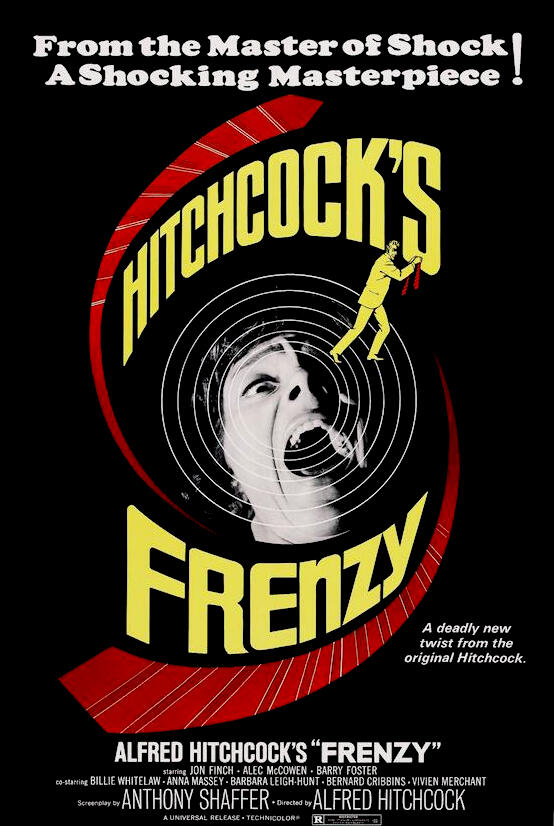
Production Company:
Universal
Released:
25th May 1972 (UK)
20th June 1972 (US)
Director:
Alfred Hitchcock
Adapted From The Novel:
Goodbye Piccadilly, Farewell Leicester Square (1966)
by Arthur La Bern
Cast:
| Richard Blaney | Jon Finch |
| Robert Rusk | Barry Foster |
| Brenda Blaney | Barbara Leigh-Hunt |
| Babs Milligan | Anna Massey |
| Chief Inspector Oxford | Alec McCowen |
| Mrs. Oxford | Vivien Merchant |
| Hetty Porter | Billie Whitelaw |
| Johnny Porter | Clive Swift |
| Felix Forsythe | Bernard Cribbins |
| Sergeant Spearman | Michael Bates |
The film opens with a view of the county hall building, along the River Thames in London, where a politician is giving an optimistic speech to a crowd about the River Thames' future cleanliness. During this speech, the body of a naked woman, a victim of the "necktie murderer," washes up on the shore.
Richard Blaney is fired from his bartending job for allegedly stealing alcohol, despite his girlfriend Babs Milligan's attempts to defend him. Blaney goes to see his friend Bob Rusk, a market trader in Covent Garden. Rusk is sympathetic and offers him money, which Blaney declines, and a good betting tip on a horse for a race that day.
Later, Blaney visits his ex-wife Brenda at her marriage bureau. Despite his agitation over her success, she sympathetically offers to take him to dinner. Their conversation reveals Blaney’s life struggles and how unlucky he’s been with numerous ventures.
Although Blaney sees Brenda safely home, we see him sleeping in a Salvation Army hostel, where another man in the next bed tries to steal money from his coat pocket; money Blaney didn't know was there, which had evidently been placed by Brenda.
The next day, Bob Rusk visits Brenda's office, and we learn he is a client of the bureau, using a different name. He makes insinuations towards her and, after she rejects his advances, he rapes and murders her.
Due to circumstantial evidence, the police suspect Blaney, and he goes on the run with Babs, who, though suspicious at first, supports him. They find cover with Johnny Porter and his wife, an old RAF friend of Blaney's, who are staying at the Hilton Hotel. However, he is awakened the next morning to learn from the morning newspapers that Babs has been killed by the neck-tie murderer. His friends refuse to help him, fearing they would be regarded as accomplices by the police, which would affect their plans to run a business in France.
Blaney turns to Rusk for help, but things take a dramatic twist as Blaney sets out to prove his innocence.
Sleuth
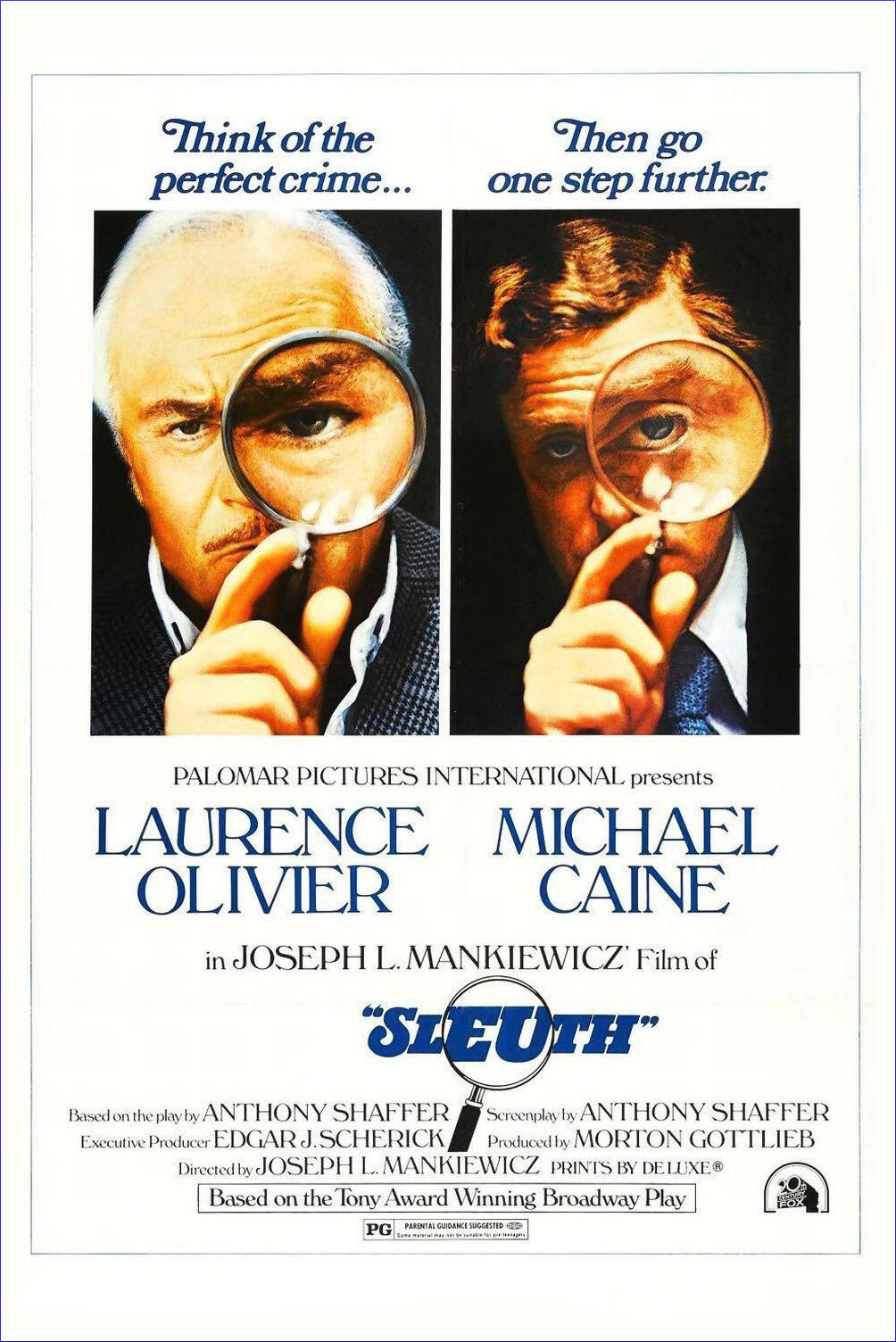
Production Company:
Palomar Pictures
Released:
10th December 1972 (US)
12th July 1973 (UK)
Director:
Joseph L. Mankiewicz
Cast:
| Andrew Wyke | Laurence Olivier |
| Milo Tindle | Michael Caine |
| Inspector Doppler | Alec Cawthorne |
| Det. Sergeant Tarrant | John Matthews |
| Marguerite Wyke | Eve Channing |
| Police Constable Higgs | Teddy Martin |
Adapted by Shaffer himself, the film follows the play faithfully with only a few, minor differences. The film also makes use of the technical advantages, making toy props appear to come to life as if they too are characters in the film.
The scenes of Andrew Wyke's manor house were filmed at Athelhampton House, Dorchester, as were the gardens containing the labyrinth for the opening scene. The stunning interiors, designed by Ken Adam, were filmed at Pinewood Studios.
For more details regarding the plot, see the Sleuth stage play entry.
The Wicker Man
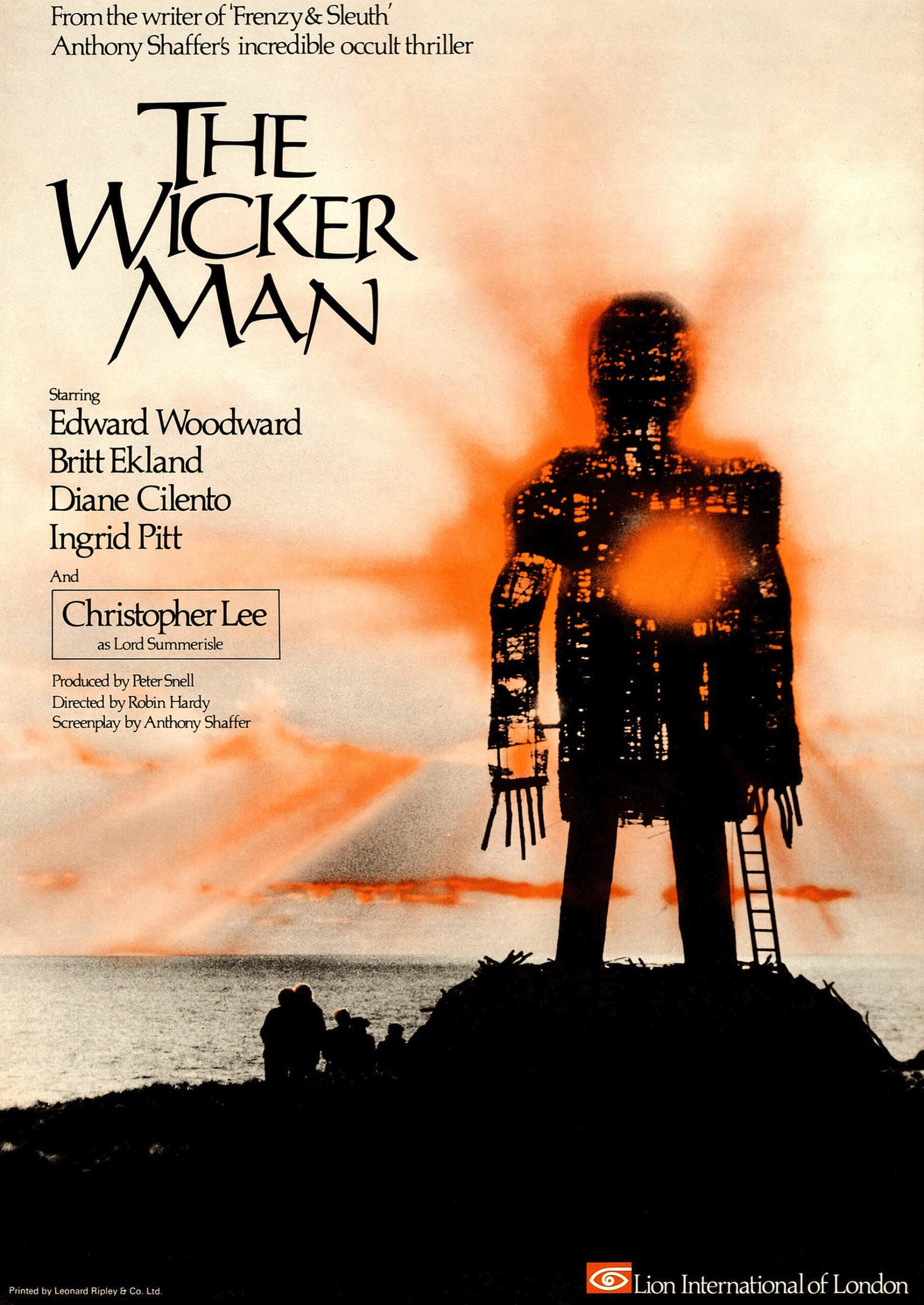
Production Company:
British Lion
Released:
6th December 1973 (UK)
15th May 1974 (US)
Director:
Robin Hardy
Cast:
| Sergeant Howie | Edward Woodward |
| Lord Summerisle | Christopher Lee |
| Miss Rose | Diane Cilento |
| Willow | Britt Ekland |
| Librarian | Ingrid Pitt |
| Alder MacGregor | Lindsay Kemp |
| Harbour Master | Russell Waters |
| Old Gardener | Aubrey Morrris |
| May Morrison | Irene Sunters |
| School Master | Walter Carr |
| Oak | Ian Campbell |
| Hairdresser | Leslie Blackater |
| Broome | Roy Boyd |
| Rowan Morrison | Geraldine Cowper |
| Woman With Baby | Barbara Ann Brown |
The film follows Sergeant Neil Howie, a devout Christian police officer, who travels to Summerisle, a remote island off the west coast of Scotland. He has received an anonymous letter from the island about the disappearance of a young girl, Rowan Morrison. Upon arrival, Sergeant Howie finds the locals uncooperative and dismissive, claiming not to know Rowan or her whereabouts.
As he investigates, Sergeant Howie encounters strange customs and pagan rituals among the islanders, who seem to openly celebrate fertility and have abandoned traditional Christian practices. Despite his efforts to gather information, he is met with resistance and confusion.
Having found Rowan’s unmarked grave, Sergeant Howie visits Lord Summerisle for permission to have her body exhumed for a pathologist’s report. Here, he learns from Lord Summerisle about the history of the island and why their beliefs in the old Gods and appeasing them is an important way of life on the island. Summerisle is known for its fruit production, particularly apples, and appeasing the Gods results in a bountiful harvest.
The investigation takes a dark turn as Sergeant Howie delves deeper into the island's secrets, uncovering disturbing truths about their beliefs and practices. As the May Day festivities approach, tension builds, and Sergeant Howie realises that his quest for answers may have led him into a dangerous trap.
Murder On The Orient Express
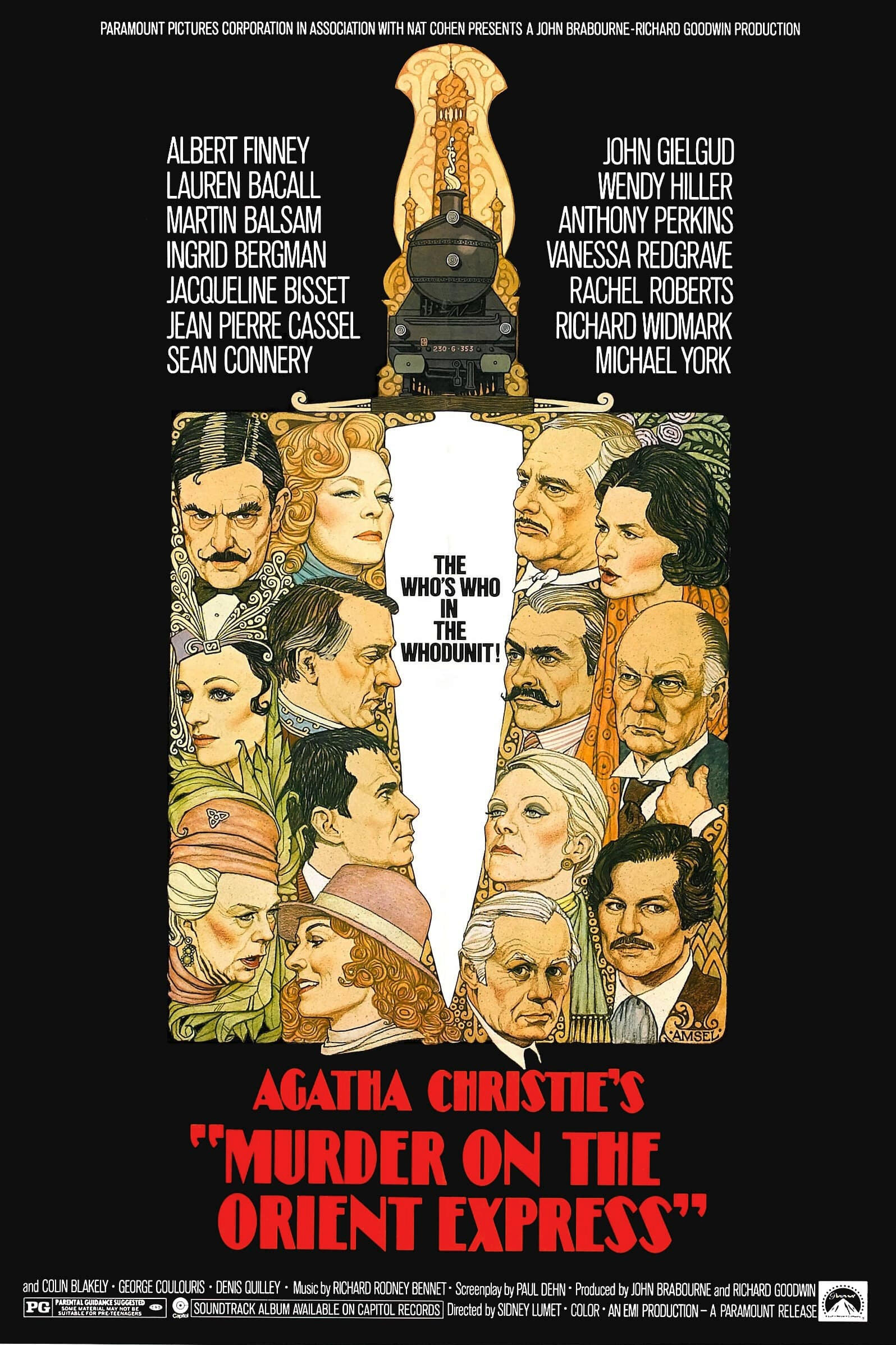
Production Company:
EMI Films
Released:
21st November 1974 (UK)
24th November 1974 (US)
Screenplay:
Paul Dehn
Anthony Shaffer (Uncredited)
Director:
Sidney Lumet
Adapted From The Novel:
Murder On The Orient Express (1934)
by Agatha Christie
Cast:
| Hercule Poirot | Albert Finney |
| Mrs. Hubbard | Lauren Bacall |
| Bianchi | Martin Balsam |
| Greta | Ingrid Bergman |
| Countess Andrenyi | Jacqueline Bisset |
| Pierre | Jean Pierre Cassel |
| Col. Arbuthnott | Sean Connery |
| Beddoes | John Geilgud |
| Princess Dragomiroff | Wendy Hiller |
| McQueen | Anthony Perkins |
| Mary Debenham | Vanessa Redgrave |
| Hildegarde | Rachel Roberts |
| Ratchett | Richard Widmark |
| Count Andrenyi | Michael York |
| Hardman | Colin Blakely |
| Doctor | George Coulouris |
| Fascarelli | Denis Quilley |
Set in December 1935, the story unfolds aboard the opulent Orient Express, which becomes stranded in Yugoslavia due to heavy snowfall.
The journey begins with Hercule Poirot reluctantly boarding the train, where he encounters a diverse array of passengers. Among them is Samuel Ratchett, a wealthy American businessman who, fearing for his life, attempts to hire Poirot as his bodyguard. Poirot, however, declines the offer.
The plot thickens when Ratchett is found brutally murdered in his compartment, having been stabbed twelve times. As Poirot delves into the investigation, he uncovers a shocking truth: Ratchett is actually Lanfranco Cassetti, a notorious gangster connected to the kidnapping and murder of young Daisy Armstrong five years prior.
As the detective meticulously interviews the passengers, he discovers that many of them have intricate connections to the Armstrong case, each harbouring their own motives for wanting Cassetti dead. The investigation reveals a web of secrets and lies, challenging Poirot's understanding of justice and morality.
As the story unfolds, Poirot finds himself grappling with a moral dilemma that goes beyond the simple identification of a murderer. The detective must confront his own beliefs about justice and retribution, leading to a conclusion that leaves audiences pondering the complexities of human nature and the true meaning of justice.
Death On The Nile
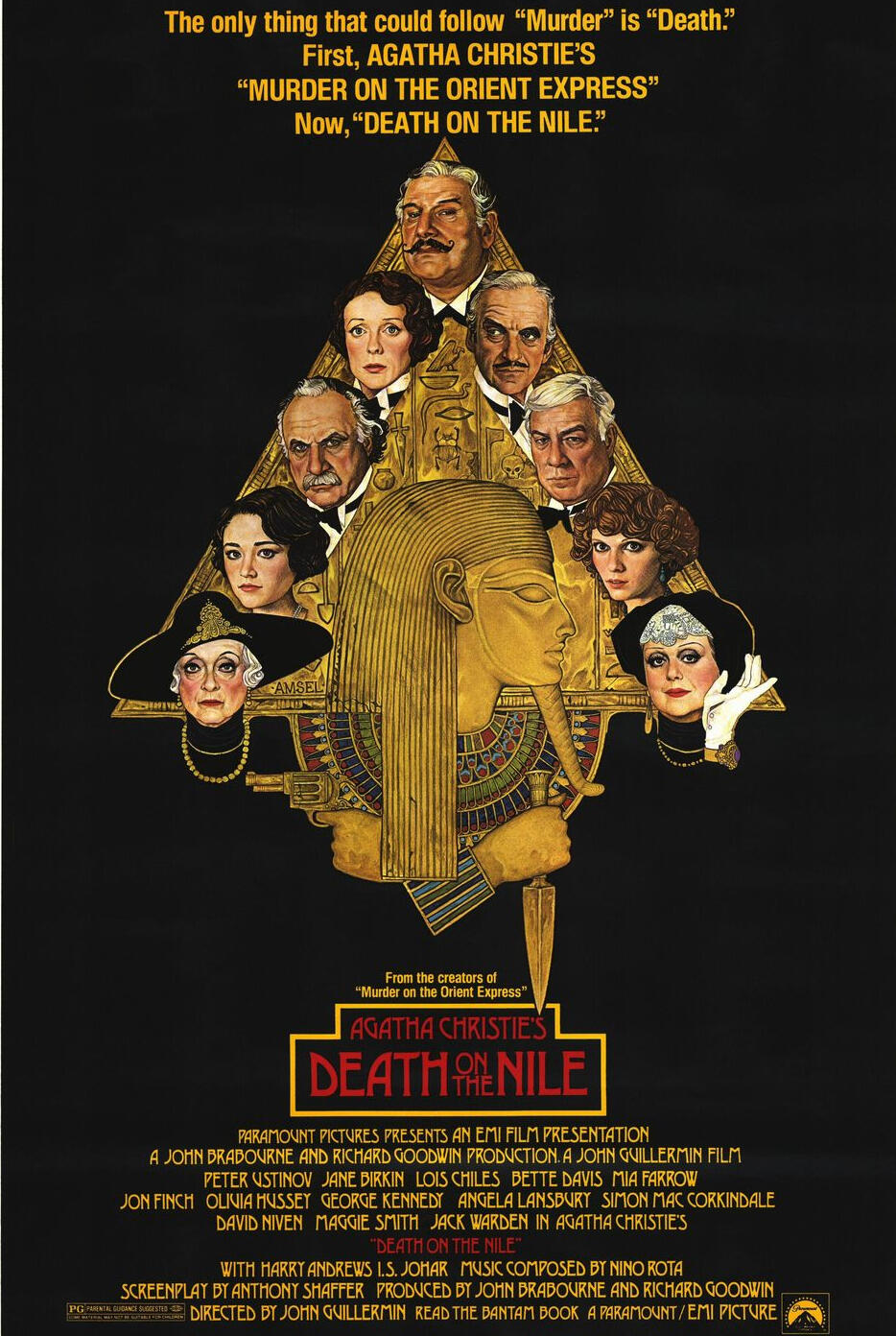
Production Company:
Mersham Productions
Released:
29th September 1978 (US)
23rd October 1978 (UK)
Director:
John Guillermin
Adapted From The Novel:
Death On The Nile (1937) by Agatha Christie
Cast:
| Hercule Poirot | Peter Ustinov |
| Louise Bourget | Jane Birkin |
| Linnet Ridgeway | Lois Chiles |
| Mrs. Van Schuyler | Bette Davis |
| Jacqueline De Bellefort | Mia Farrow |
| Mr. Ferguson | Jon Finch |
| Rosalie Otterbourne | Olivia Hussey |
| Manager Of The Karnak | I.S. Johar |
| Andrew Pennington | George Kennedy |
| Mrs. Salome Otterbourne | Angela Lansbury |
| Simon Doyle | Simon MacCorkindale |
| Colonel Race | David Niven |
| Miss Bowers | Maggie Smith |
| Dr. Bessner | Jack Warden |
| Barnstaple | Harry Andrews |
| Rockford | Sam Wanamaker |
Jacqueline de Bellefort introduces her fiancé, Simon, to the wealthy Linnet Ridgeway in the hope of gaining employment for him. Linnet meets Simon, and they quickly fall in love, leading to their marriage. They honeymoon in Egypt, where they encounter a bitter Jacqueline, who has been following them and threatens to continue to harass them wherever they go. Hercule Poirot, who is on vacation, observes these interactions.
The newlyweds embark on a Nile cruise aboard the paddle ship the Karnak and are joined by various guests including Poirot and his friend, Colonel Race.
The other passengers include Mrs. Van Schuyler, who shows interest in Linnet's pearls, while Miss Bowers discloses a past grievance against Linnet's family. It becomes apparent that Linnet and the author, Salome Otterbourne, have a legal dispute over personal comments in Salome's book and Louise Bouget confronts Linnet about unpaid wages, which Linnet dismisses.
Linnet's guardian, Andrew Pennington, attempts to have Linnet sign legal papers without reading them, raising suspicion.
Colonel Race privately informs Poirot that he's investigating Andrew Pennington for potential embezzlement of Linnet's inheritance.
Tensions rise and the plot takes a sinister twist as the other passengers are driven by their motives to exact revenge on Linnett and, later, she is found dead in her room with a gunshot wound to the head.
Poirot and Colonel Race work on the case which leads to more deaths and a shocking conclusion.
Absolution
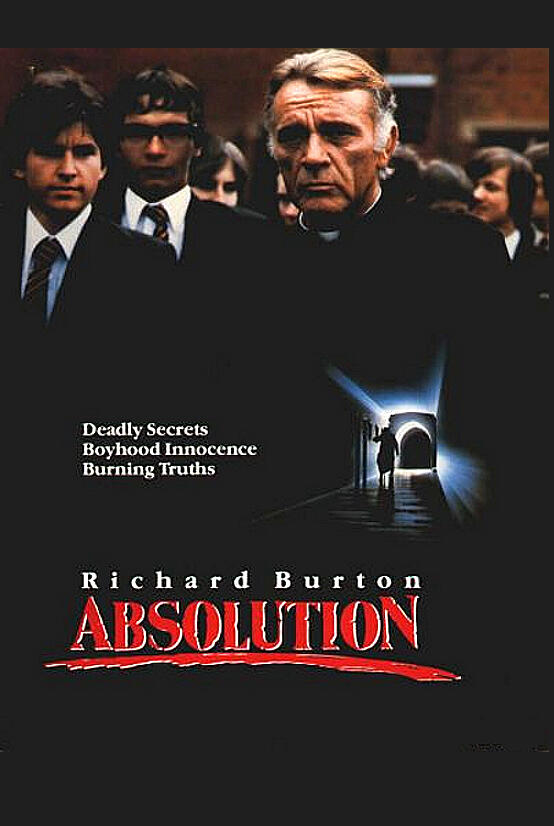
Production Company:
Bulldog Productions
Released:
5th November 1981 (UK)
1st July 1988 (US - as Murder By Confession)
Director:
Anthony Page
Based On The Stage Play:
Play With A Gypsy (1969) by Anthony Shaffer
Cast:
| Father Goddard | Richard Burton |
| Benjie | Dominic Guard |
| Arthur | Dai Bradley |
| Blakey | Billy Connolly |
| Headmaster | Andrew Keir |
| Brigadier Walsh | Willoughby Gray |
| Father Hibbert | Preston Lockwood |
| Father Matthews | James Ottaway |
| Father Clarence | Brook Williams |
| Father Piers | Jon Plowman |
| Father Henryson | Robin Soans |
| Mr. Gladstone | Trevor Martin |
| Louella | Sharon Duce |
| First Policeman | Brian Glover |
| Second Policeman | Dan Meaden |
| Miss Froggatt | Hilary Mason |
| Mrs. Hoskins | Hilda Fenemore |
| Cawley | Robert Addie |
| Peterson | Kevin Hart |
| Gregory | Philip Leake |
| O'Dowd | Michael Crompton |
The film begins with Blakey, a travelling biker, arriving at St. Anthony's School in search of work. However, Father Goddard, the school's authority figure, dismisses him, clearly uncomfortable with his presence.
Father Goddard attends a rehearsal for a school production of Patience and watches in distaste as it becomes apparent that he does not like Arthur Dyson, one of the pupils in the play.
The arrival of Blakey, introduces an element of rebellion that captivates Benjie who forms a bond with him, engaging in activities that represent freedom from the school's oppressive atmosphere. He spends his free time with Blakey, fishing and drinking whisky into the late hours by the camp fire.
Father Goodard speaks to Benjie about his new friendship and asks him to promise to not see Blakey again. Reluctantly, Benjie makes his promise.
Later, we see Benjie at a picnic with Blakey and, Louella, another traveller and tells them about the promise he made to Father Goddard. Blakey and Louella make fun of the situation and suggest he tells Father Goddard about having wild orgies in the woods; Blakey tells him to say it in confession, pointing out that the priest can’t do anything about it.
Benjie confesses to Father Goddard about taking part in acts of a sexual nature with Blakey and his girlfriend, disgusting the priest and who has Blakey removed by the police. Benjie goes to see Blakey, only to find him hurt and the camp in disarray. An argument between them ensues, and becomes violent.
The narrative takes a dark turn when Benjie confesses to Father Goddard about killing Blakey and burying him in the woods. Bound by the seal of confession, Father Goddard investigates, leading to a series of deceptions and manipulations orchestrated by Benjie and Arthur, who has offered to help Benjie.
Tension grows as Benjie continues to make confessions of wanting to commit murder, sending Father Goddard into a state of torment and helplessness, until only he himself can put an end to it.
Rough Cut
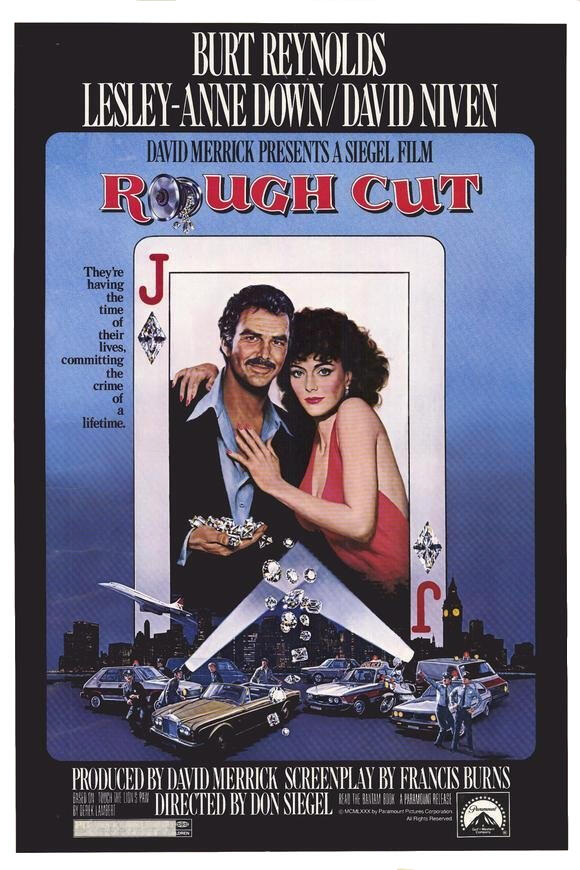
Production Company:
Paramount Pictures
Released:
20th June 1980 (US)
18th July 1980 (UK)
Screenplay:
Francis Burns
Anthony Shaffer (Uncredited)
Director:
Don Siegel
Cast:
| Jack Rhodes | Burt Reynolds |
| Gillian Bromley | Lesley-Anne Down |
| Ch. Insp. Cyril Willis | David Niven |
| Nigel Lawton | Timothy West |
| Ernest Mueller | Patrick MaGee |
| Ferguson | Al Matthews |
| Sheila | Susan Littler |
| Inspector Vanderveld | Joss Ackland |
| Mrs. Willis | Isobel Dean |
| De Gooyer | Wolf Kahler |
| Pilbrow | Andrew Ray |
| Ronnie Taylor | Julian Holloway |
| Maxwell Levy | Douglas Wilmer |
| Tobin | Geoffrey Russell |
In the glittering world of London's high society, Jack Rhodes, a wealthy American with a penchant for jewel theft, finds himself captivated by the enigmatic Gillian Bromley at a lavish soirée. Their instant connection, fuelled by a shared passion for the criminal arts, quickly blossoms into a romantic entanglement.
Unbeknownst to Jack, Gillian is caught in a web of deception orchestrated by Chief Inspector Cyril Willis of Scotland Yard. The seasoned detective, on the brink of retirement, is determined to make Jack his final catch. Using Gillian as his unwitting pawn, Willis sets a trap involving a shipment of uncut diamonds bound for Antwerp.
Despite sensing the ruse, Jack's competitive spirit and attraction to Gillian compel him to pursue the heist. He meticulously assembles a team of skilled criminals, each with their own unique talents. In a surprising turn, Jack chooses Gillian as his getaway driver, replacing his initial choice at the last moment.
The heist unfolds with clockwork precision, culminating in a heart-pounding chase through the streets of London. Jack and Gillian, flush with adrenaline and the thrill of success, make their escape with the diamond shipment in tow. However, their elation is short-lived as they discover the stolen goods are nothing more than worthless quartz – a clever switch orchestrated by the cunning Inspector Willis.
As Jack and Gillian celebrate their apparent victory aboard a luxurious yacht, the air is thick with unspoken truths and hidden agendas. The chemistry between them is undeniable, yet shadows of doubt linger. Just as they toast to their future, a revelation threatens to upend everything they thought they knew about each other and the heist itself.
Evil Under The Sun
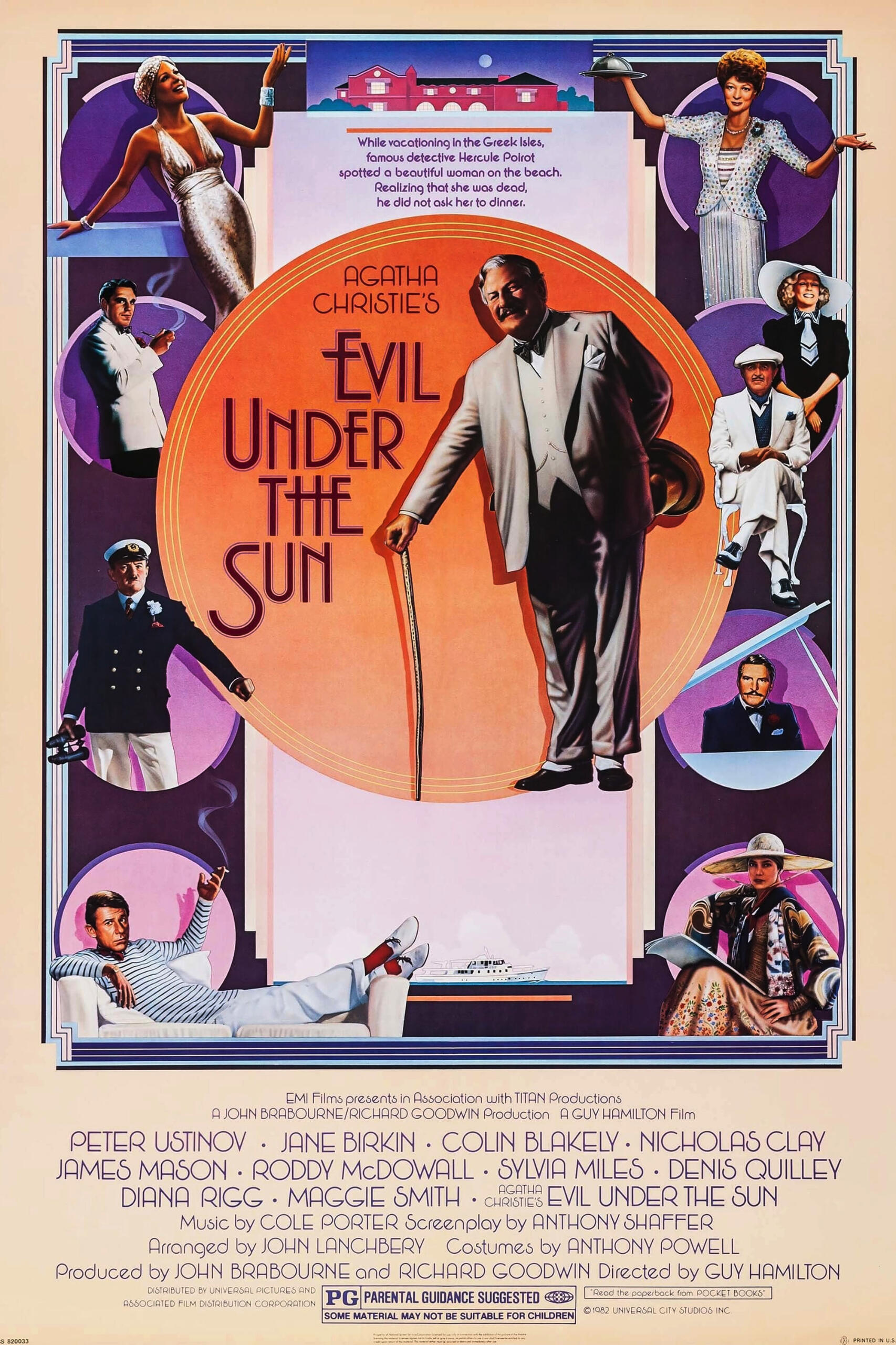
Production Company:
EMI Films
Released:
5th March 1982 (US)
23rd March 1982 (UK)
Director:
Guy Hamilton
Adapted From The Novel:
Evil Under The Sun (1941) by Agatha Christie
Cast:
| Hercule Poirot | Peter Ustinov |
| Sir Horace Blatt | Colin Blakely |
| Christine Redfern | Jane Birkin |
| Patrick Redfern | Nicholas Clay |
| Daphne Castle | Maggie Smith |
| Rex Brewster | Roddy McDowall |
| Myra Gardener | Sylvia Miles |
| Odell Gardener | James Mason |
| Kenneth Marshall | Denis Quilley |
| Arlena Marshall | Diana Rigg |
| Linda Marshall | Emily Hone |
The film opens with a young woman rushing into a police station to report a body found on the moors, setting in motion an investigation that remains unsolved. Detective Hercule Poirot is brought into the case when an insurance executive hires him to investigate a potentially fraudulent diamond claim.
Poirot's inquiry leads him to the south of France, where he meets Horace Blatt, the diamond's owner. Blatt's story of a spurned romance and a swapped jewel points Poirot towards a seaside hotel run by Daphne Castle, where the actress involved in the diamond affair is set to stay.
At the hotel, located on a remote Adriatic island, a cast of intriguing characters assembles. Among them are Patrick and Christine Redfern, Kenneth and Arlena Marshall, with Kenneth’s daughter Linda. Already at the hotel are Broadway theatrical producers Odell and Myra Gardener, and writer Rex Brewster, each harbouring their own secrets and tensions. Poirot observes the complex dynamics, noting particularly the flirtations of Arlena Marshall towards Patrick Redfern and the discomfort of her stepdaughter, Linda.
The idyllic setting is shattered when Arlena's body is discovered on the beach of a remote cove. She has been strangled. Poirot takes charge of the investigation, questioning each guest about their whereabouts and motives. As he unravels alibis and exposes lies, the detective pieces together a puzzling timeline of events.
Suspicion falls on various individuals: Kenneth Marshall, Arlena's husband with a motive of jealousy; Horace Blatt, seen arguing with the victim; and Rex Brewster, whose biography of Arlena provided a potential motive. Each denial and alibi only deepen the mystery.
As Poirot delves deeper, he uncovers a web of deception involving manipulated time, disguises, and hidden identities. The truth, when finally revealed, proves to be as shocking as it is ingenious, involving an elaborate plot of greed and betrayal.
Flesh+Blood
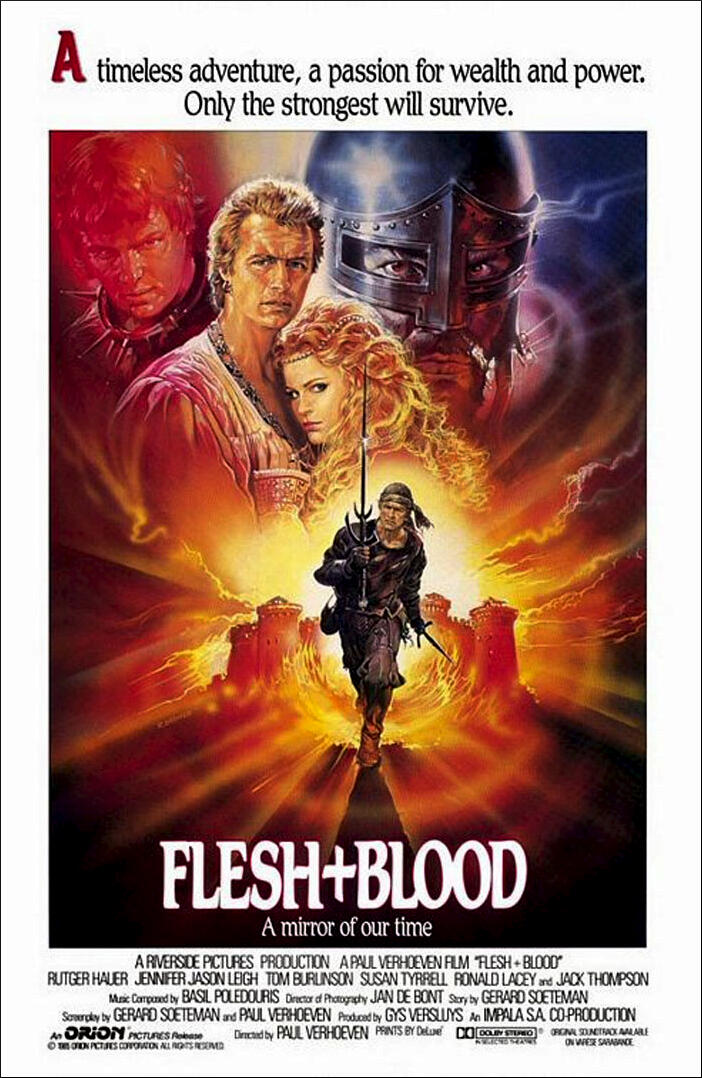
Production Company:
Riverside Pictures
Released:
30th August 1985 (US)
Screenplay:
Gerard Soeteman
Paul Verhoeven
Anthony Shaffer (Creative Consultant)
Director:
Paul Verhoeven
Cast:
| Martin | Rutger Hauer |
| Agnes | Jennifer Jason Leigh |
| Steven | Tom Burlinson |
| Hawkwood | Jack Thompson |
| Arnolfini | Fernando Hillbeck |
| Celine | Susan Tyrrell |
| Cardinal | Ronald Lacey |
| Karsthans | Brion James |
| Summer | John Dennis Johnston |
| Miel | Simon Andreu |
| Orbec | Bruno Kirby |
| Anna | Kitty Courbois |
| Polly | Marina Saura |
| Father George | Hans Veerman |
Flesh+Blood is a gritty medieval adventure set in 1501 Italy. It follows a band of mercenaries led by the charismatic Martin as they navigate a world of betrayal and survival.
The story begins when Arnolfini, a nobleman, hires the mercenaries to reclaim his city from usurpers. After a successful and violent siege, Arnolfini betrays the mercenaries, casting them out without their promised rewards. Fuelled by a desire for vengeance, Martin and his band find themselves entangled in a complex web of nobility, power, and survival.
The plot thickens when Martin's group inadvertently kidnaps Agnes, a young noblewoman betrothed to Arnolfini's son Steven. Agnes, initially a victim, begins to manipulate her captors, blurring the lines between captor and captive.
As Steven and his forces pursue the mercenaries, the conflict escalates, leading to a tense siege at a castle. The situation becomes even more perilous when it's revealed that plague has infiltrated the stronghold.
In a climactic confrontation, Martin faces off against Agnes, their complex relationship reaching a boiling point. As chaos engulfs the castle, Agnes makes a decision that will have far-reaching consequences. The film leaves viewers questioning the true nature of loyalty, love, and survival in a brutal medieval world.
Appointment With Death
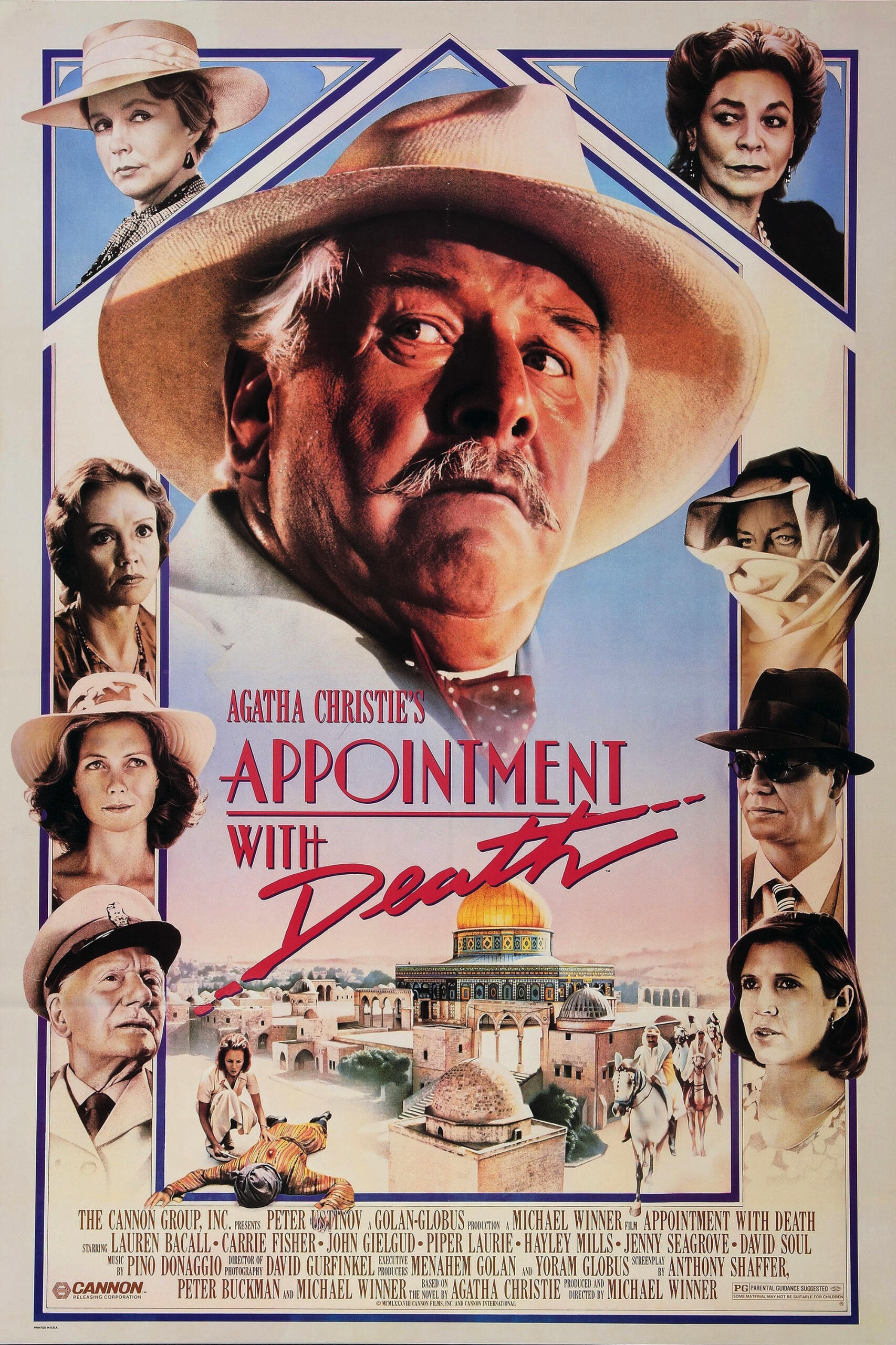
Production Company:
Cannon Group
Released:
15th April 1988 (US)
27th May 1988 (UK)
Screenplay:
Anthony Shaffer
Peter Buckman
Michael Winner
Director:
Michael Winner
Adapted From The Novel:
Appointment With Death (1938) by Agatha Christie
Cast:
| Hercule Poirot | Peter Ustinov |
| Lady Westholme | Lauren Bacall |
| Nadine Boynton | Carrie Fisher |
| Colonel Carbury | John Gielgud |
| Emily Boynton | Piper Laurie |
| Miss Quinton | Haley Mills |
| Dr. Sarah King | Jenny Seagrove |
| Jefferson Cope | David Soul |
| Lennox Boynton | Nicholas Guest |
| Carol Boynton | Valerie Richards |
| Raymond Boynton | John Terlesky |
| Ginevra Boynton | Amber Bezer |
| Captain Rogers | Douglas Sheldon |
| Healey | Mike Sarne |
| Lord Peel | Michael Craig |
Emily Boynton discovers that a second will made by her late husband would divide his estate equally among her and his stepchildren. Alarmed by the potential loss of control, she coerces the family lawyer, Jefferson Cope, into destroying the will before her children can learn of its existence, blackmailing Cope with threats of exposing his past misconduct. Reluctantly, he complies and burns the new will.
Emily organises a European holiday for her stepchildren and, as they travel, suspicions about the will's existence begin to surface among them. During their journey, Emily experiences a collapse, revealing her weak heart condition. Meanwhile, Cope secretly engages in an affair with Nadine Boynton, Emily's daughter-in-law.
The family dynamics grow increasingly tense as Emily maintains her iron grip on her stepchildren, who chafe under her domineering nature. Their travels eventually lead them to board a ship bound for Jaffa. Coincidentally, the renowned detective Hercule Poirot is also a passenger on this vessel. His keen ears pick up fragments of conversations among the Boynton family, hinting at the growing animosity towards Emily.
The situation takes a dramatic turn when Emily is discovered dead during an archaeological dig. This shocking event prompts Poirot to suspect foul play, sensing that beneath the surface lies a tangled web of family secrets and potential motives for murder.
As the investigation unfolds, Poirot meticulously interviews various suspects, each with their own possible reasons for wanting Emily out of the picture. The detective's confidence in solving the case within two days stems from his belief that people tend to reveal truths when they talk.
The plot thickens when a potential witness, Hassan, is found dead after attempting to meet with Poirot. This leads to a series of events that culminate in a tense gathering where Poirot assembles all the suspects for tea, ostensibly to discuss the case and reveal the truth.
Sommersby
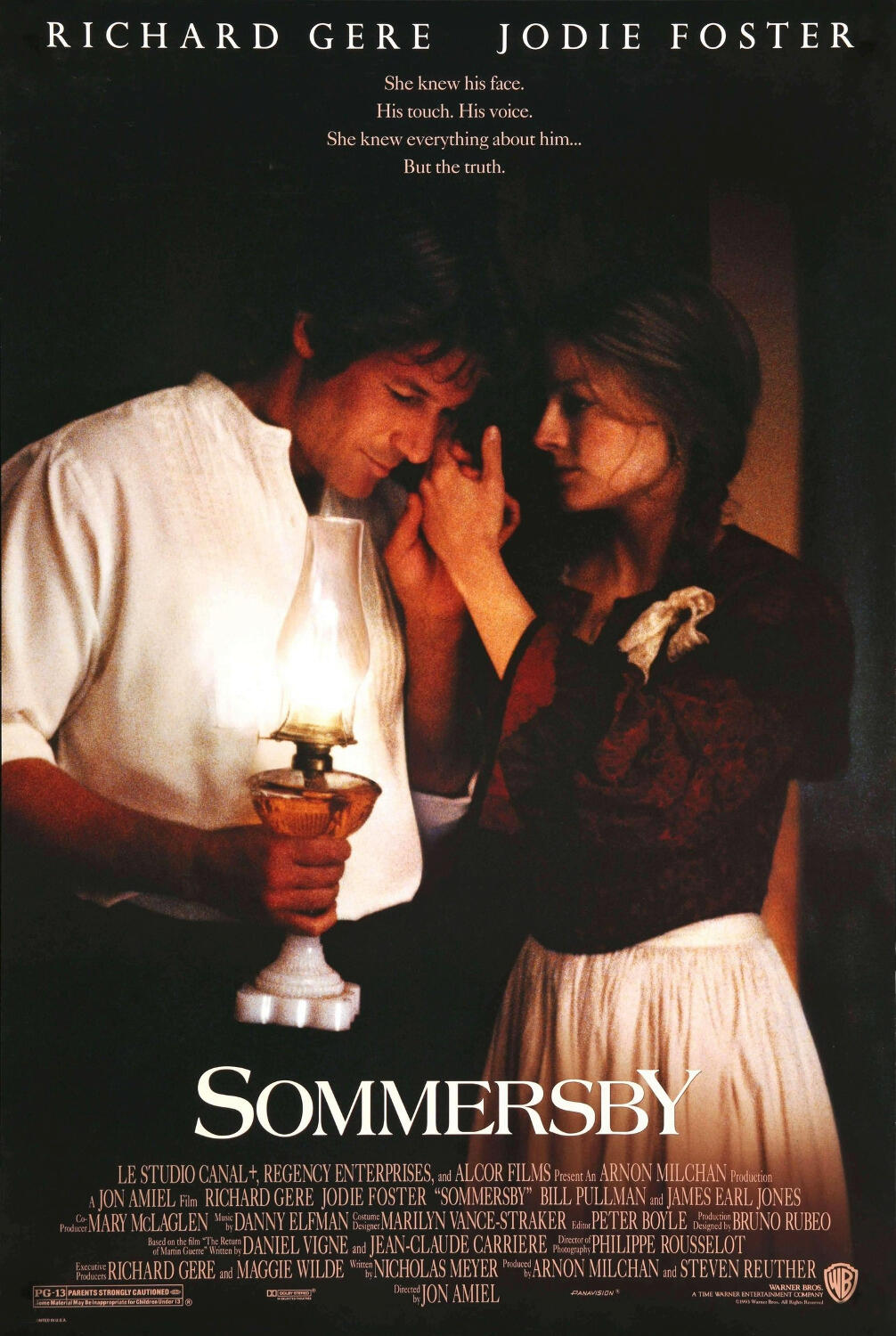
Production Company:
Regency Enterprises
Canal+
Released:
5th February 1993 (US)
23rd April 1993 (UK)
Screenplay:
Jon Amiel
Sarah Kernochan
Anthony Shaffer (Story by)
Director:
Jon Amiel
Cast:
| Jack | Richard Gere |
| Laurel | Jodie Foster |
| Buck | Lanny Flaherty |
| Travis | Wendell Wellman |
| Orin | Bill Pullman |
| Little Rob | Brett Kelley |
| Reverend Powell | William Windom |
| Esther | Clarice Taylor |
| Joseph | Frankie Faison |
| Dick Mead | Ronald Lee Ermey |
| Doc Evans | Richard Hamilton |
| Mrs. Evans | Karen Kirschenbauer |
| Storekeeper Wilson | Carter McNeese |
Jack Sommersby returns to his farm in Vine Hill, Tennessee, after six years of fighting in the Civil War. His wife, Laurel, and their son, Robbie, are surprised and happy to see him, but their reunion is complicated by Laurel's budding relationship with Orin Meacham, a neighbour who helped manage the farm during Jack's absence.
As Jack settles back into life, he proposes a new tobacco farming venture to the townsfolk, offering them land and resources. However, suspicions arise about his true identity when it becomes apparent that he has changed significantly during the war.
The story takes an intriguing turn when Jack visits town to get new shoes fitted, only to discover his feet have shrunk two sizes. He humorously attributes this to being drunk when he made the shoe template. Later, Jack gathers the townsfolk and proposes they grow tobacco, offering them land, tools, and fertilizer while allowing them to keep half the crop. Initially met with scepticism due to his lack of funds, the townsfolk are persuaded when Laurel offers to sell her grandmother's brooch to help finance the venture.
As the community begins to work together on this new endeavour, tensions escalate. Jack stands against racism and fights for the rights of black farmers in the community, which leads to confrontations with the Ku Klux Klan. The townspeople and Laurel grapple with whether he is truly Jack or an impostor named Horace Townsend.
Laurel finds herself torn between her growing love for this new Jack and her suspicions about his true identity.
Contact
If you would like to get in touch, then please do fill out the form below.
Your email details will not be used for any mailing lists or passed on to marketing agencies.
andy taylor © 2025.
This website and its contents are copyright of Andy Taylor © Anthony Shaffer. 2025. All rights reserved.
Any redistribution or reproduction of part or all of the contents in any form is prohibited other than the following:
- You may print or download to a local hard disk extracts for your personal and non-commercial use only.
- You may copy the content to individual third parties for their personal use, but only if you acknowledge the website as the source of the material.
Images displayed on this website remain the property of their respective owners. These images are used with permission or under fair use guidelines. Unauthorised use or reproduction of these images is strictly prohibited.
